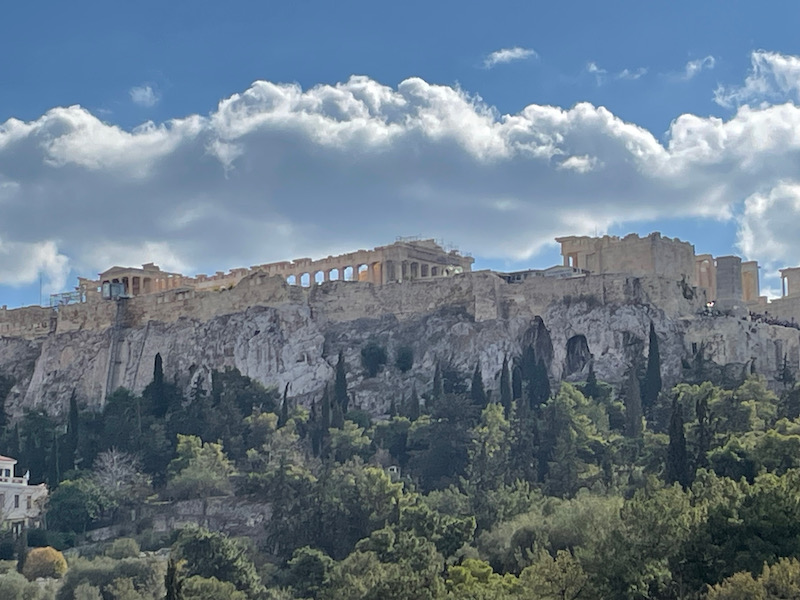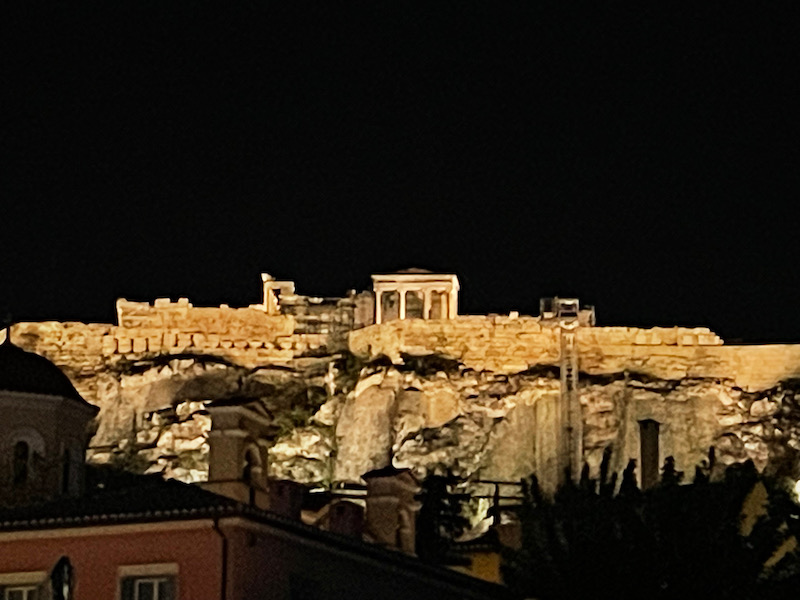Our Blog - Greece 2024 - Athens
We have been to Athens before, but a long time ago (pre-blog, in fact). It was part of a trip that included the islands of Santorini and Crete, but we spent most of our Athens time on the Acropolis. This time, we spent 1 day in Athens at the very end of the vacation and we did "Athens not including the Acropolis". But you will see pictures of the Acropolis, both daytime and nighttime pictures, but they will all be from down below looking up.
There is no way to write up the history of Athens in a single page ... it is one of the world's oldest cities, with its recorded history spanning over 3,400 years, and its earliest human presence beginning somewhere between the 11th and 7th millennia BC. Classical Athens was one of the most powerful city-states in ancient Greece and if you read a history book, they did a lot of fighting between the city-states in Peloponnese as well against the Persians. It was a centre for democracy, the arts, education and philosophy, and it is often regarded as the birthplace of democracy. Now it is a huge metropolis that looks rather impressive as you arrive, with buildings that seem to go on forever, down the hills to the water. The urban population is a bit over 3.6 million!
Since we only had 1 day, we selected our hotel based on a combination of easy airport access and easy "ancient Athens" access. Syntagma Square ticked off both boxes. Syntagma square, or Constitution Square, is a 2-level square with a lovely fountain in the middle, surrounded by park benches and shade trees. The Tomb of the Unknown Soldier, honoring all Greeks who have lost their lives in wars serving their country, is here as well. Across the street from the upper-level of the square is the Hellenic Parliament building, a historic building that once was home to the Greek Royal Family. Constructed in 1840, the neoclassical palace was initially the official residence of King Otto, Greece's 1st monarch. The construction marked the end of Turkish occupation and was funded by Otto's father, King Ludwig of Bavaria. Damaged by a fire in the early 20th century, the Royal Family relocated to a new palace, which today serves as the Presidential Mansion.
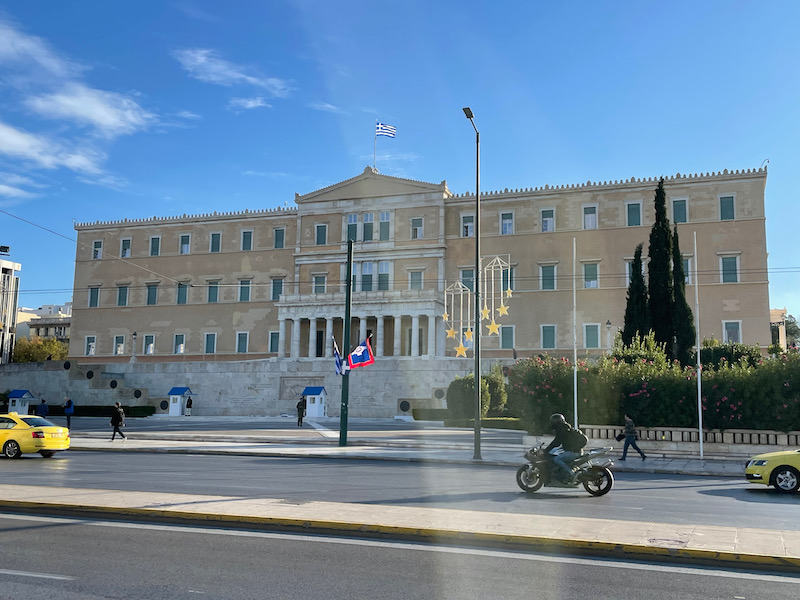
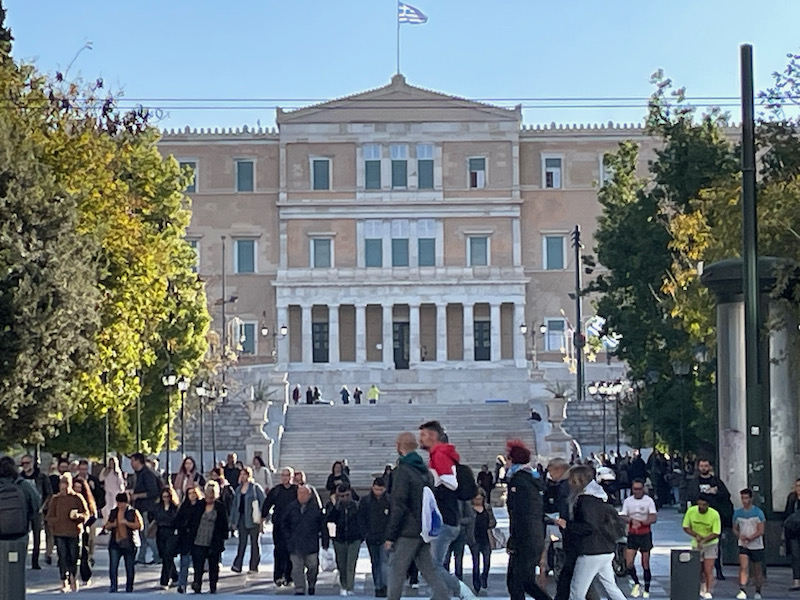
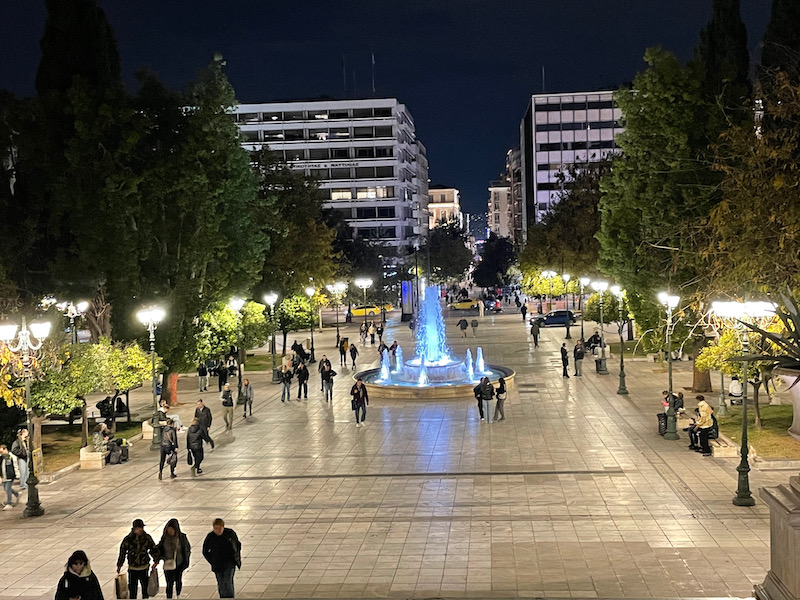
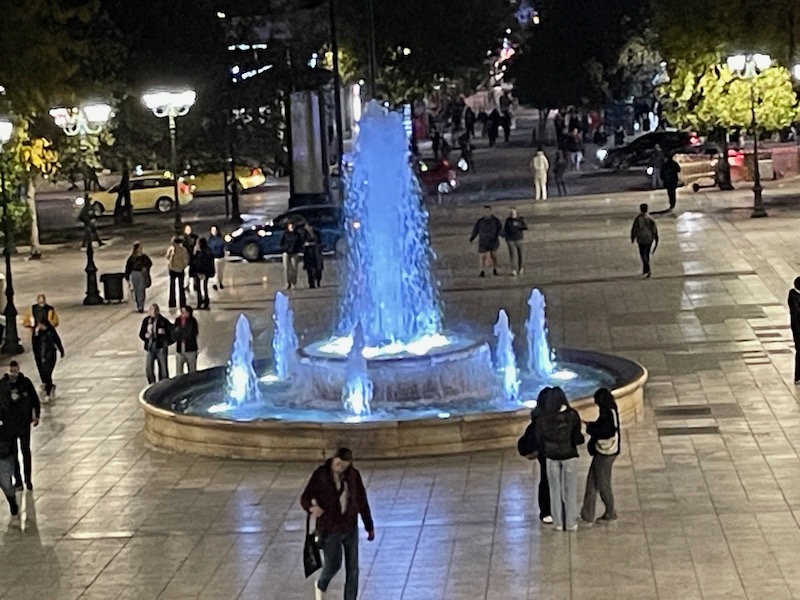
The Metropolitan Cathedral, popularly known as the "Metropolis", was started in 1842 and took 20 years to complete. To erect the colossal walls, marble from 72 dismantled churches across the country had been gathered. Measuring 130 feet in length, 65 feet wide, and 80 feet tall, it is the largest religious building in the city. Across the front is a very colorful mosaic. It was created in the 19th century and depicts the Annunciation, the passage in the Gospel of Luke where the angel Gabriel appears to the Virgin Mary to announce that she will bear a savior named Jesus. The Greek words on the middle top are taken directly from Luke 1:28, and are the first words the angel uses to greet Mary "Hail, O Highly Favored One."
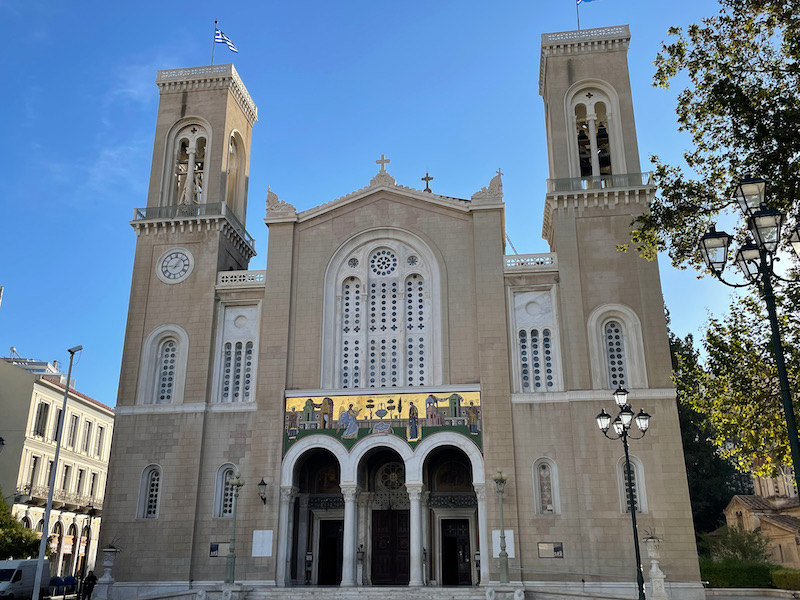
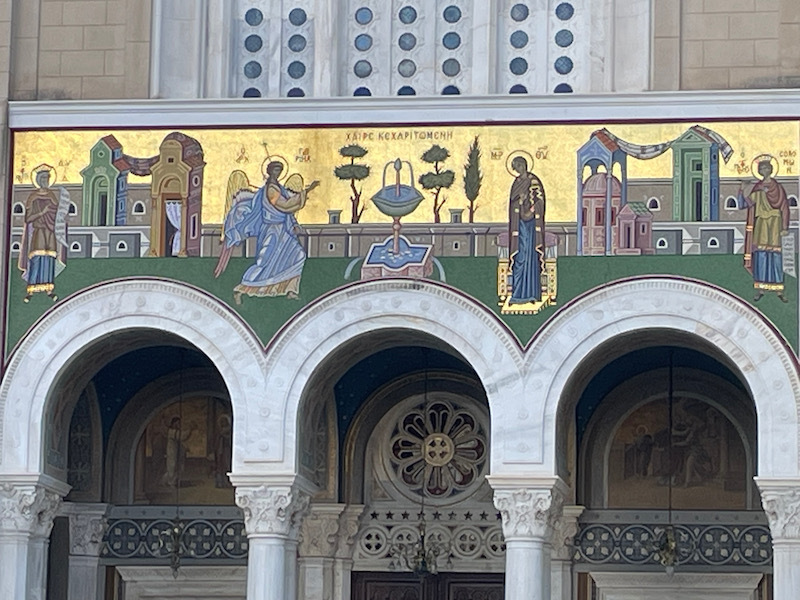
In keeping with the Greek Orthodox faith, the interior is lavishly adorned with icons, murals, and intricate decorations. We didn't end up going in very many Greek Orthodox churches, but the few that we did go into all were covered "head to toe" with paintings and decorations. You can see the multiple arches held up by columns, and the large dome.
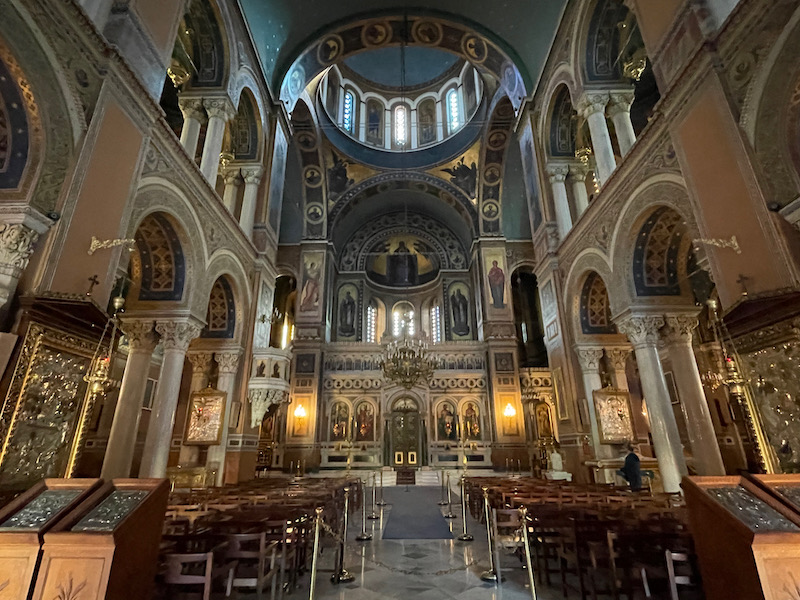
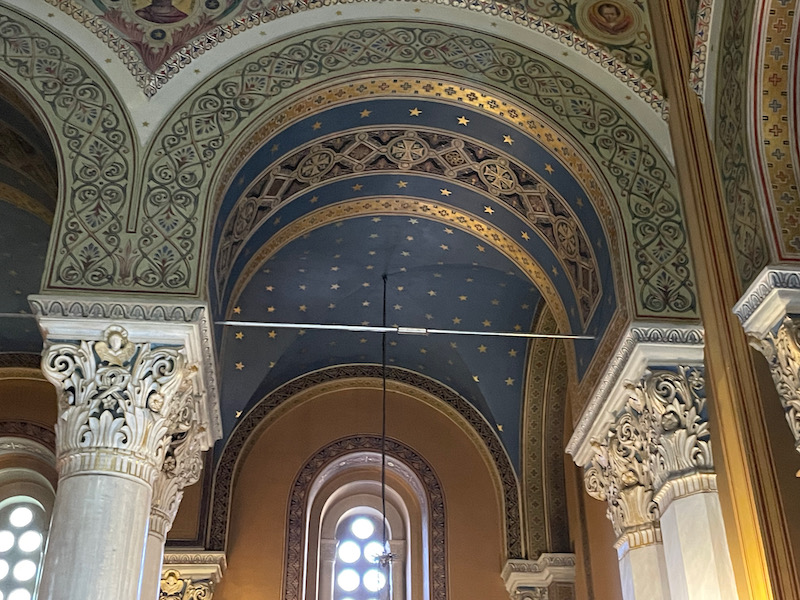
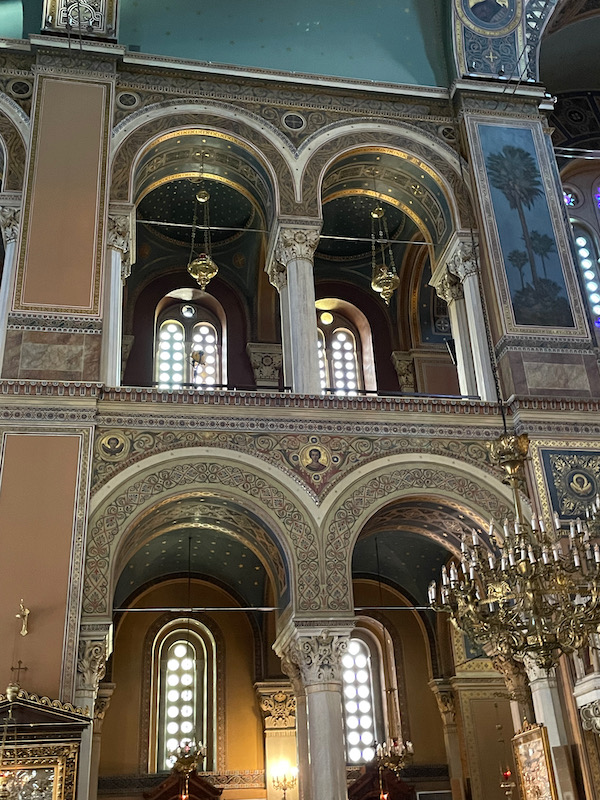
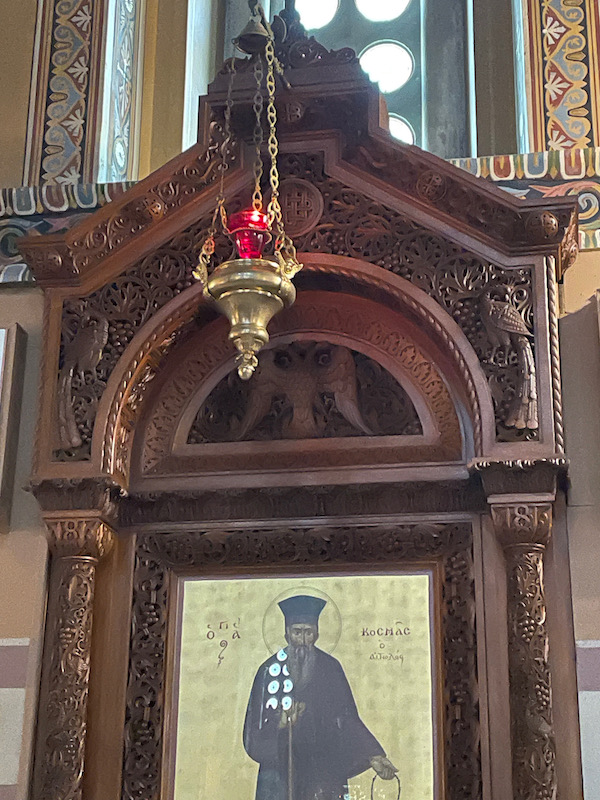
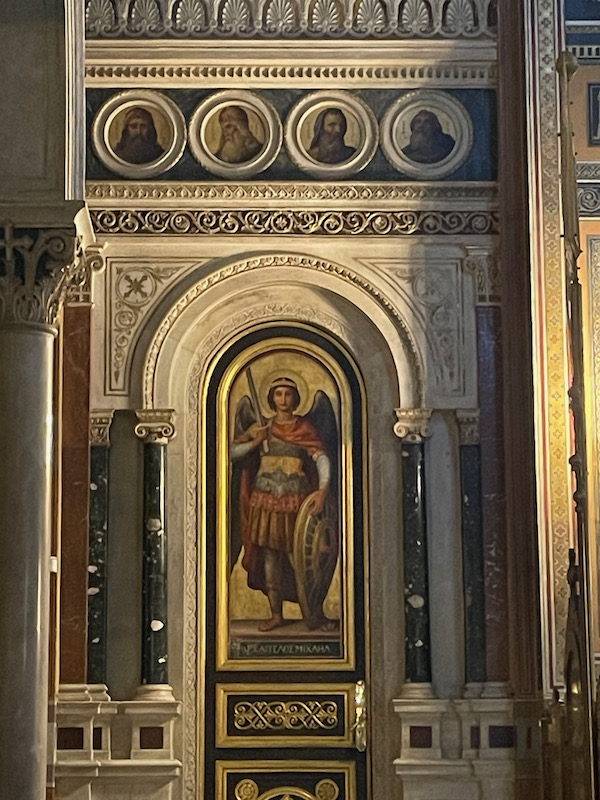
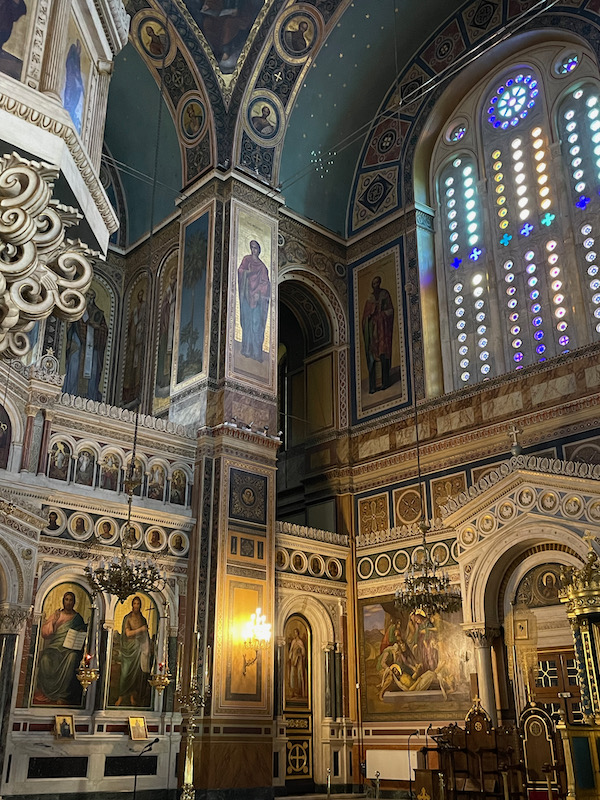
Inside the temple are the tombs of two saints – Saint Philothéi and Patriarch Gregory V. This one is the reliquary of Patriarch Gregory V, he served as the Patriarch of Constantinople and was executed in 1821. Greek sailors rescued his body from the Bosphorus and took it to Odessa, Russia. Half a century later, it was brought back to Athens.
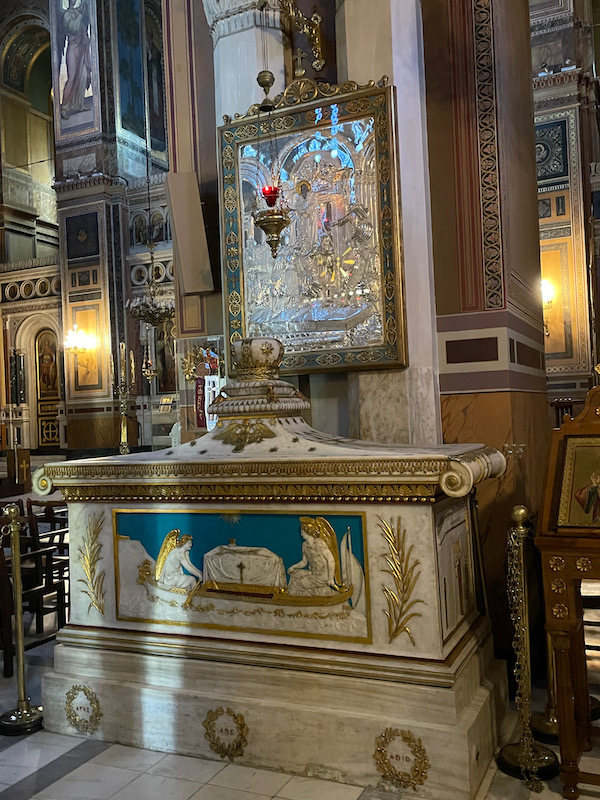
This is what I think is called the iconostasis, which a wall of icons and religious paintings that separates the public portion of the church from the sanctuary where the tabernacle is located. And then the angels and Mary and the Christ child is in the half-dome over the tabernacle.
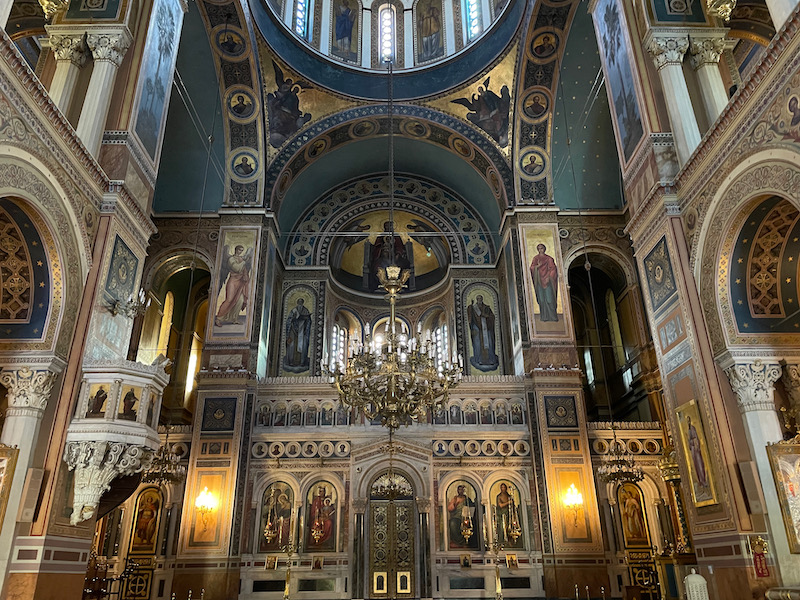
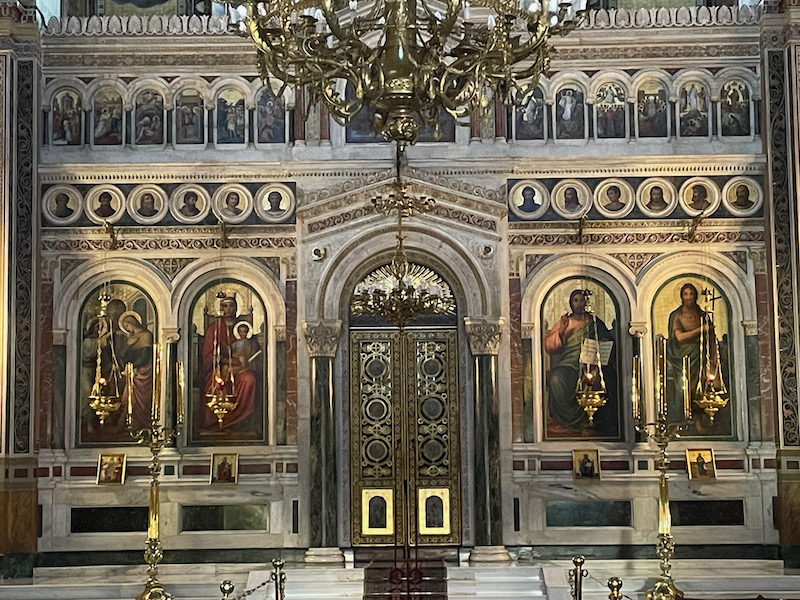
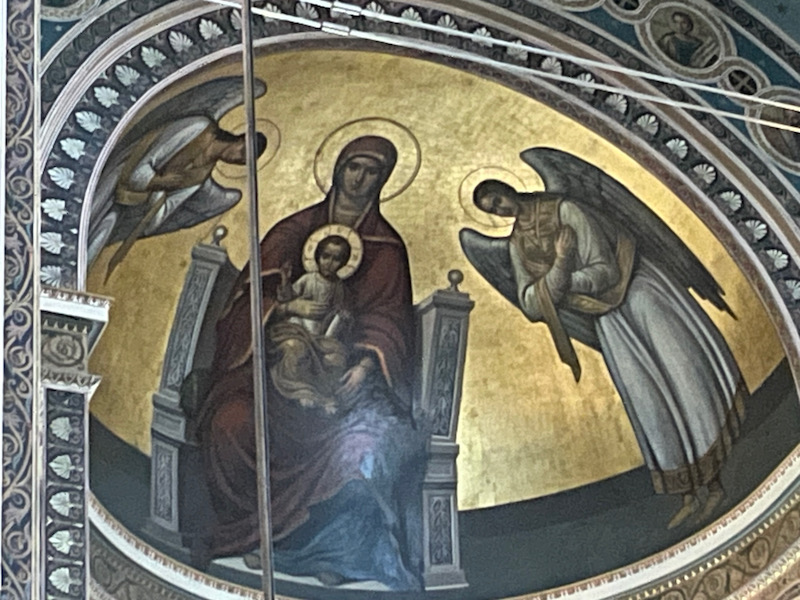
In the Mitropoleos Square in front of the cathedral stand two statues. The first is that of Constantine XI, the last emperor of the Eastern Roman Empire. The one I show here is of Archbishop Damaskinos who was Archbishop of Athens during World War II and was Regent for King George II and Prime Minister of Greece in 1946. There are a set of marble lions guarding the steps.
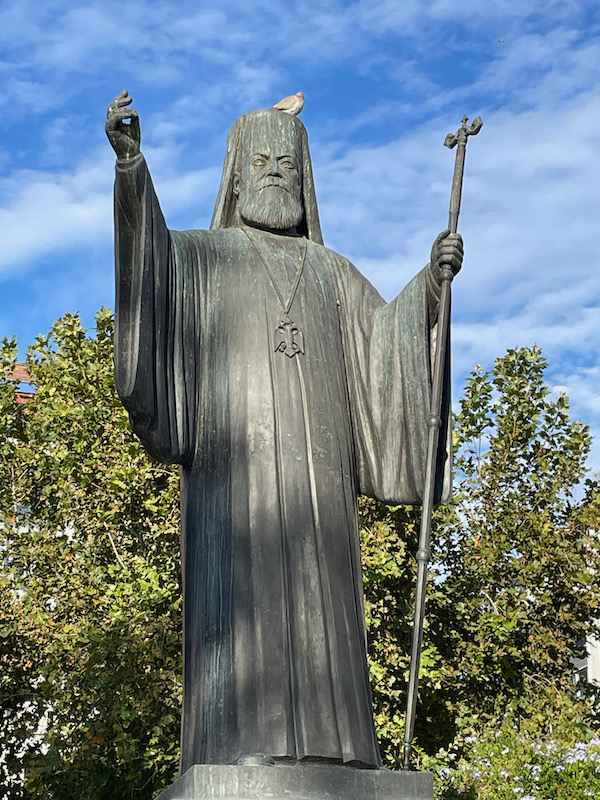
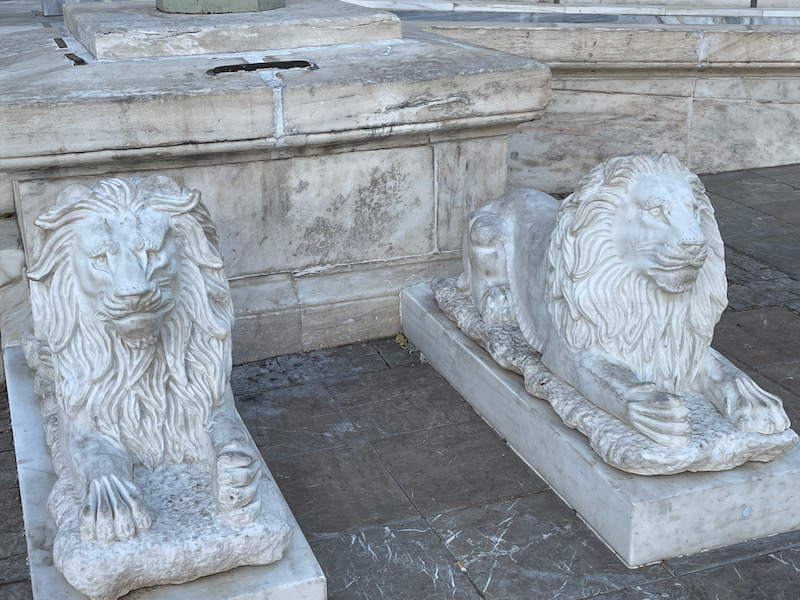
Continuing down the high-traffic shopping area of Ermou Street, we ran straight into the Church of Panagia Kapnikarea. This little Byzantine church, believed to have been constructed around 1050, is one of the city's oldest. Following a common pattern among early Christian structures, it sits atop an ancient Greek temple dedicated to a deity, possibly Athena (the protector of Athens) or Demeter (goddess of the harvest). When King Otto I wanted to design the new city layout for Athens, there was a consideration to demolish the church. Fortunately, King Ludwig I of Bavaria, a prominent supporter of the arts in Europe, stepped in to safeguard its grandeur, and the fact that it appears somewhat out of place only enhances its charm. The church's exterior showcases a mosaic from 1936 depicting the Virgin Mary holding Jesus. It wasn't open and there was a sign that said that it had "irregular hours" :-)
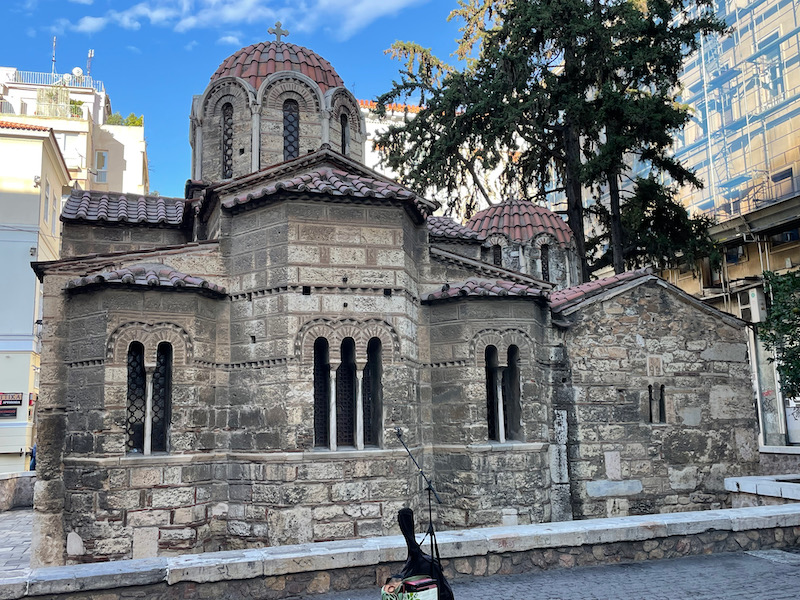
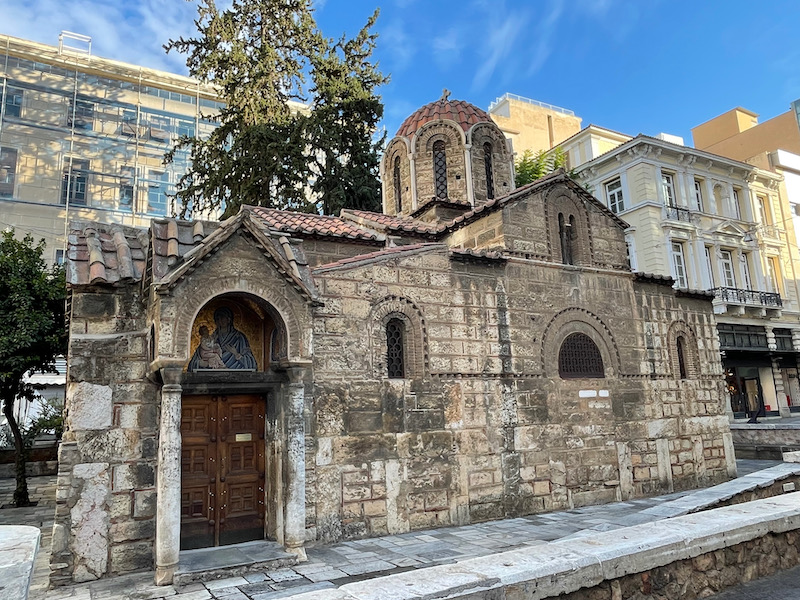
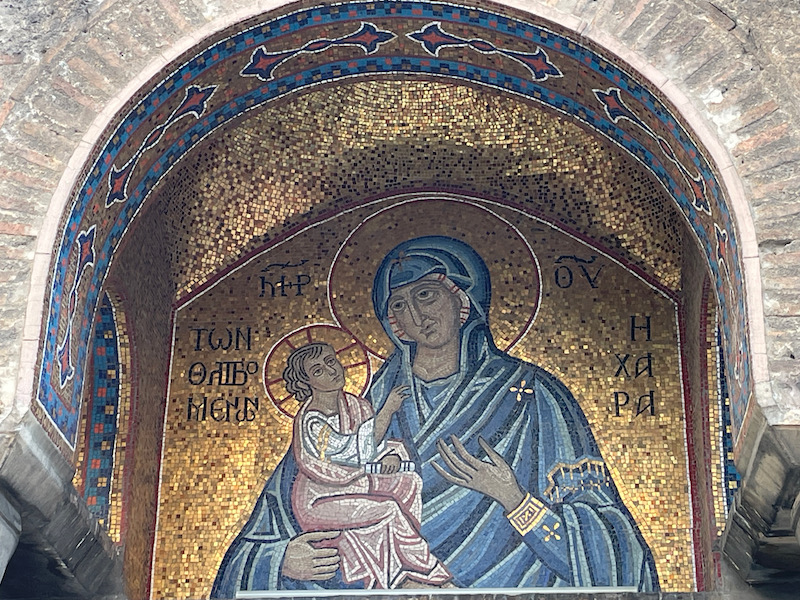
The Kerameikos Archaeological Site encompasses the primary cemetery of ancient Athens along with a substantial section of the ancient wall. It isn't on the main "tourist route" as it is a bit of a walk from the Acropolis and the Ancient Agora, but it was a bit interesting. We just took a peek from outside of the fence, but you can see the remains of several buildings and one of the main roads that crossed it.
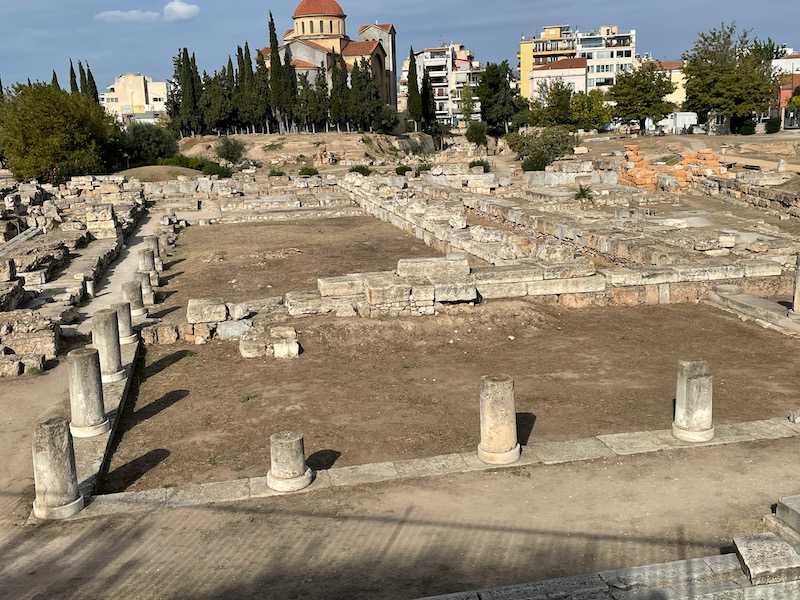
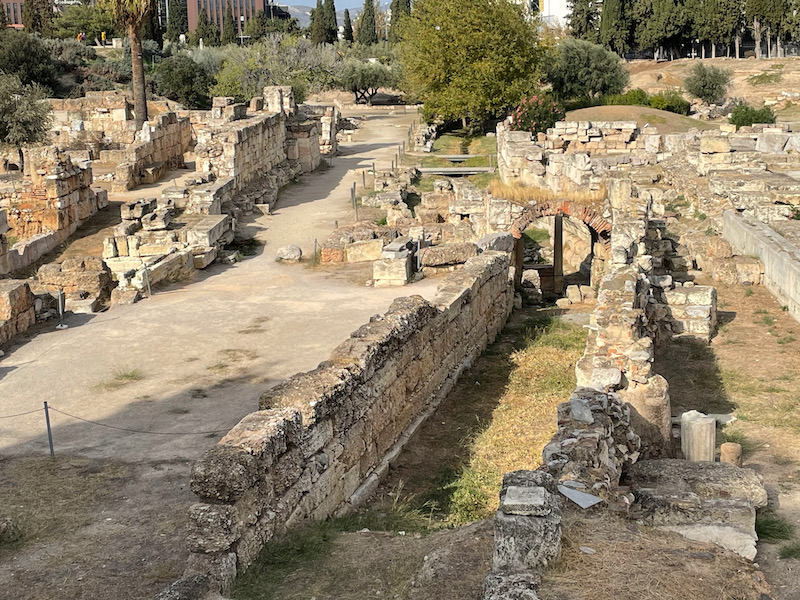
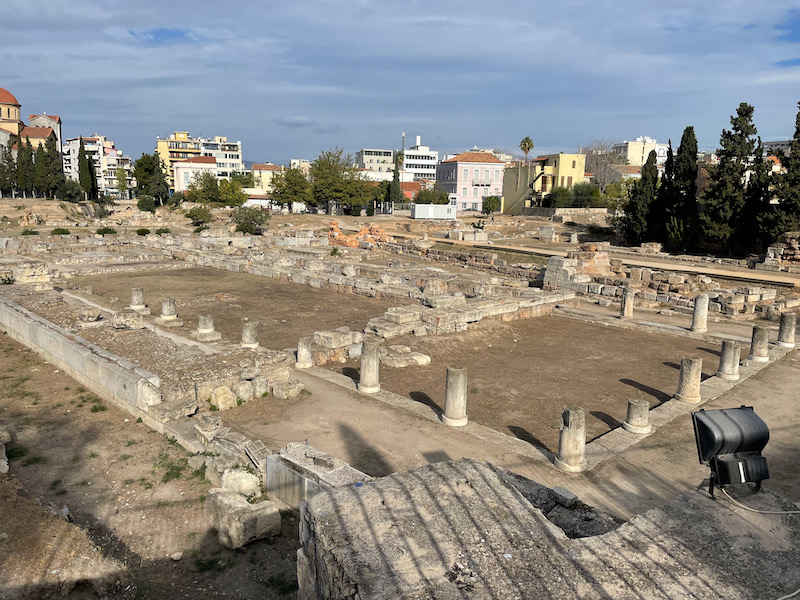
The main place that I wanted to walk through was the Ancient Agora, nestled beneath the hill of the Acropolis. It is a large site that contains the remnants of what was once a vast and intricate marketplace complex from around 150 AD. This is where basically everything happened ... administration, temples, altars, shops, political discussions, and voting. It was within the Agora council buildings, law courts, and streets that democracy took root and thrived. Most of the buildings are just outlines or piles of stones. Some of the Stoa's have parts of the columns lined up to show the outline.
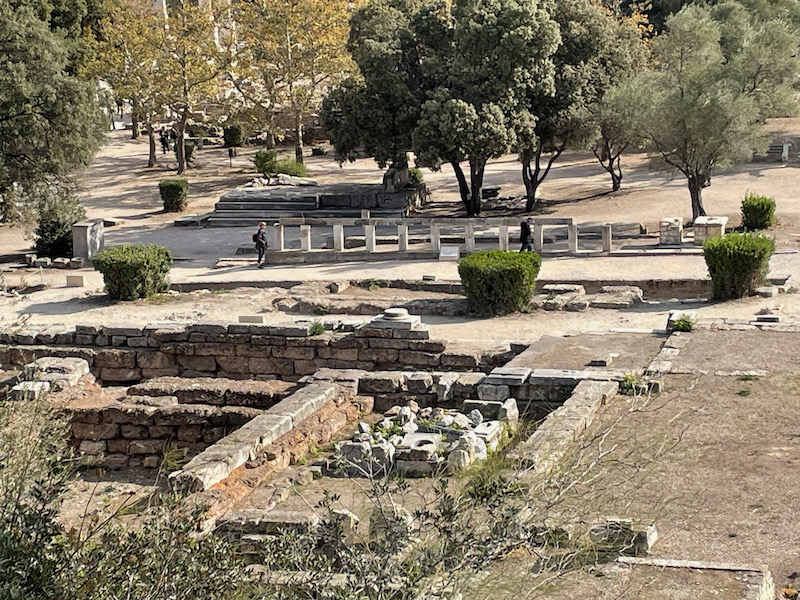
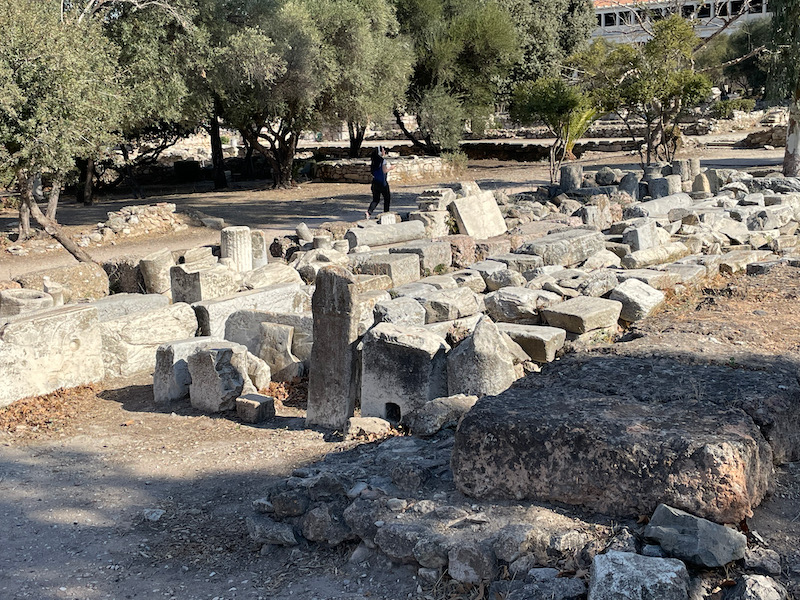
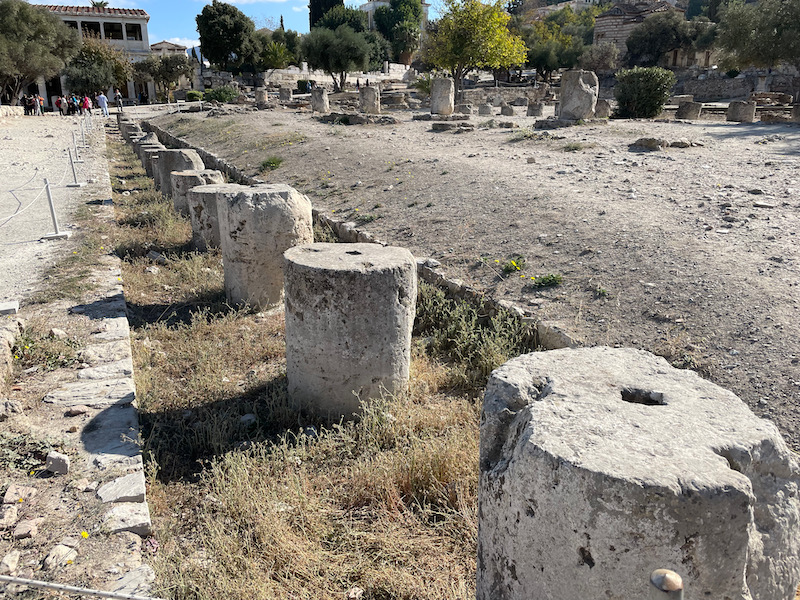
The most impressive thing (for me at least) is the Temple of Hephaestus, the god of metallurgy. It is one of the best-preserved ancient temples in Greece, thanks to its conversion to the Greek Orthodox church between the 7th and the 19th centuries. In Greek mythology, Hephaestus was the deity associated with fire, metalworking, blacksmiths, and artisans. He alone possessed the skill to craft the indestructible bronze residences in which the other Olympian gods lived. Started in around 449 BC, it sits up on a hill within the Agora, which makes it even more impressive. The construction of the Parthenon was going on around the same timeframe and so it took around 30 years to complete due to a shortage of human and material resources. I've talked about the writings of Pausanias in the 2nd century AD, and in his writings, he writes that the temple once housed bronze statues of both Athena and Hephaestus.
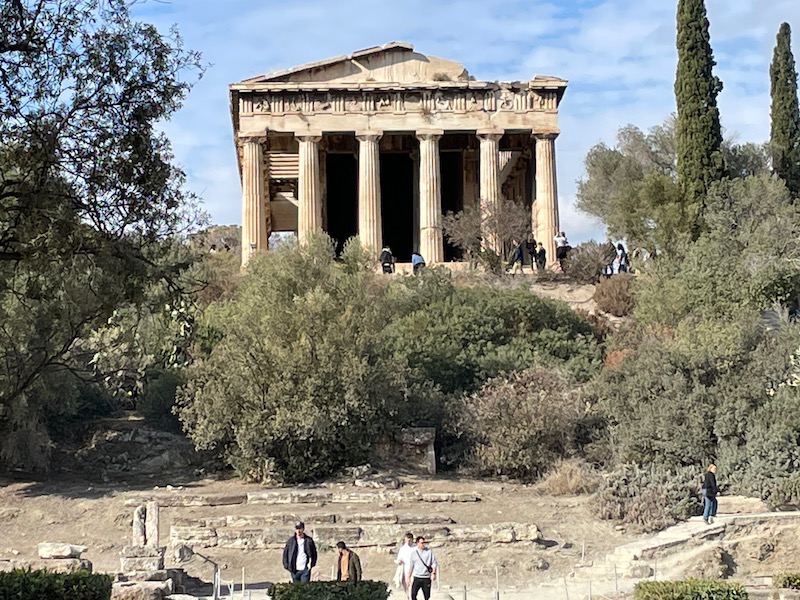
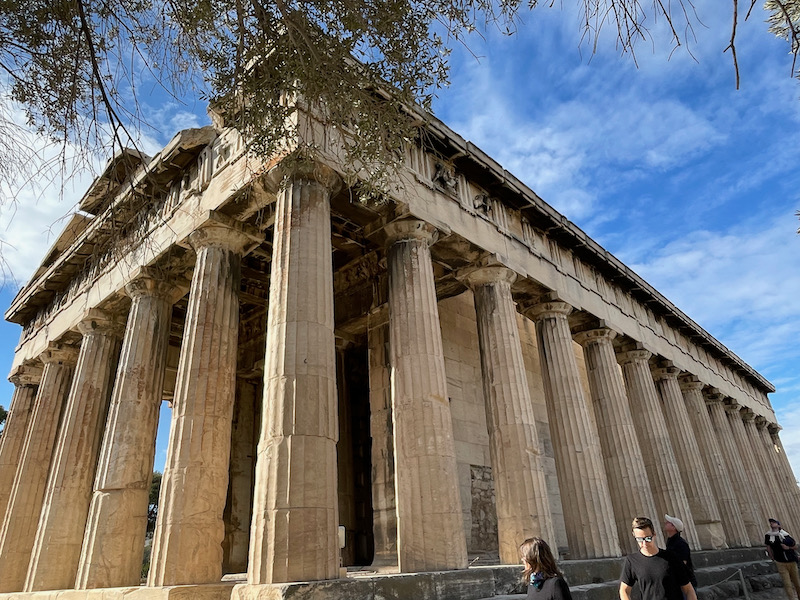
The frieze under the pediment on the side that faces the Agora have carvings showing the Labors of Hercules.
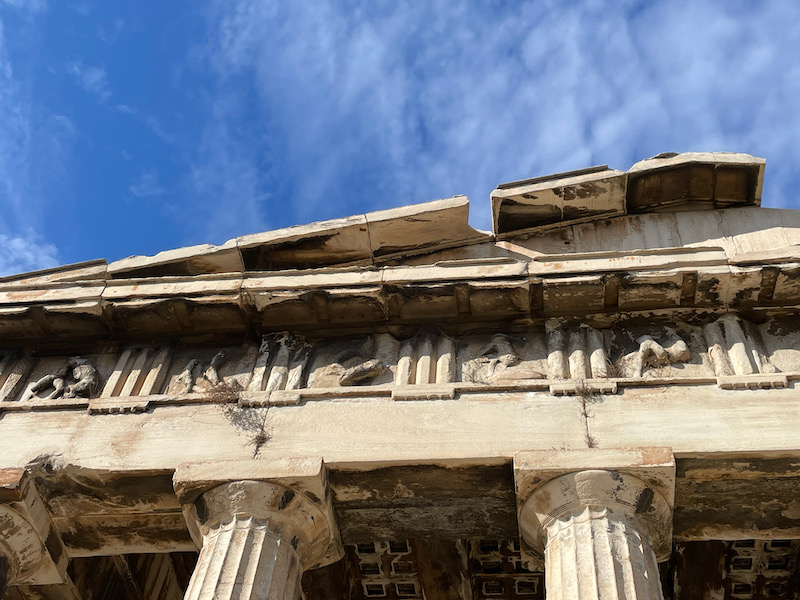
Thanks to the temple not being destroyed, you get an amazing look at a lot of the original structure, including these interesting ceiling tiles between the outside columns and the inner temple walls.
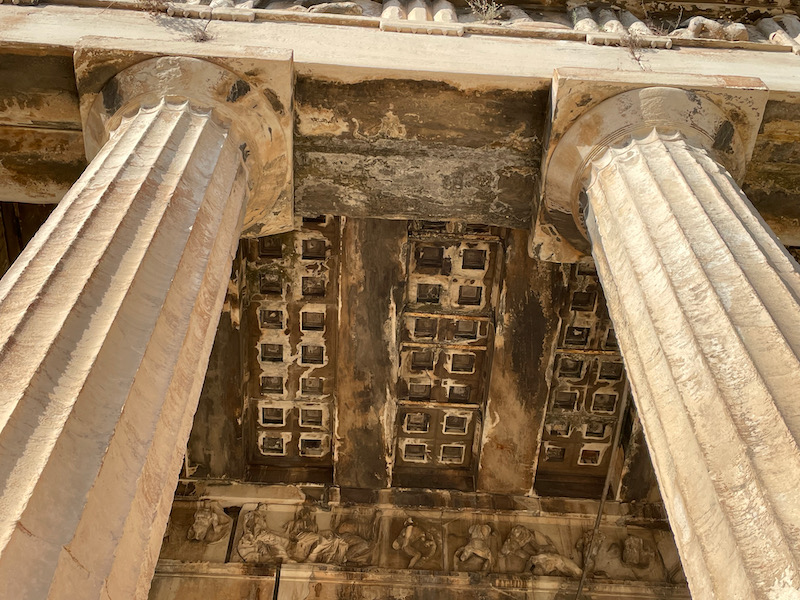
On the long sides, there are also reliefs carved, I think these show the Labors of Theseus.
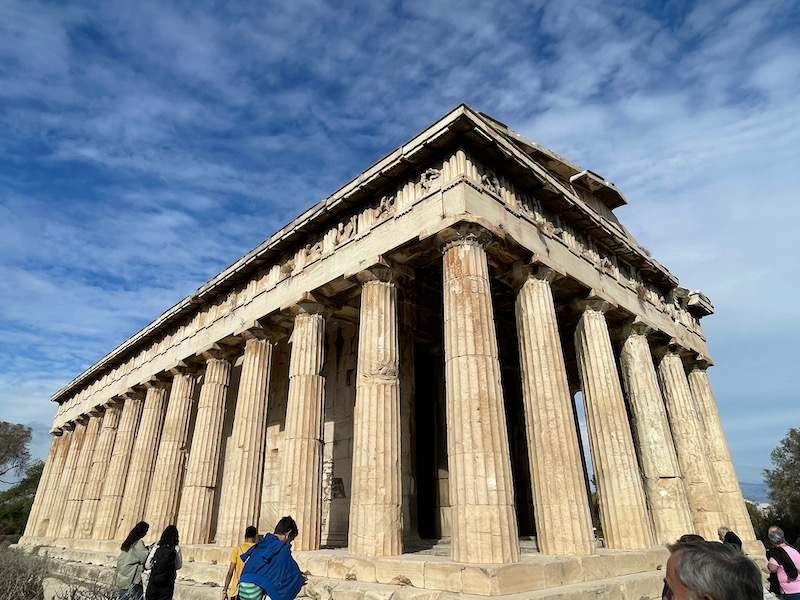
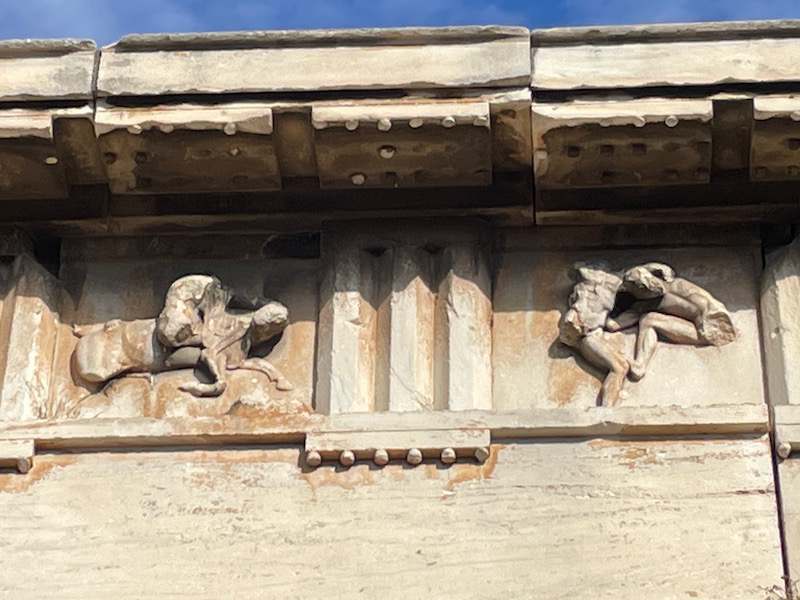
This is the other side of the temple, with the basic Doric decorations on the frieze.
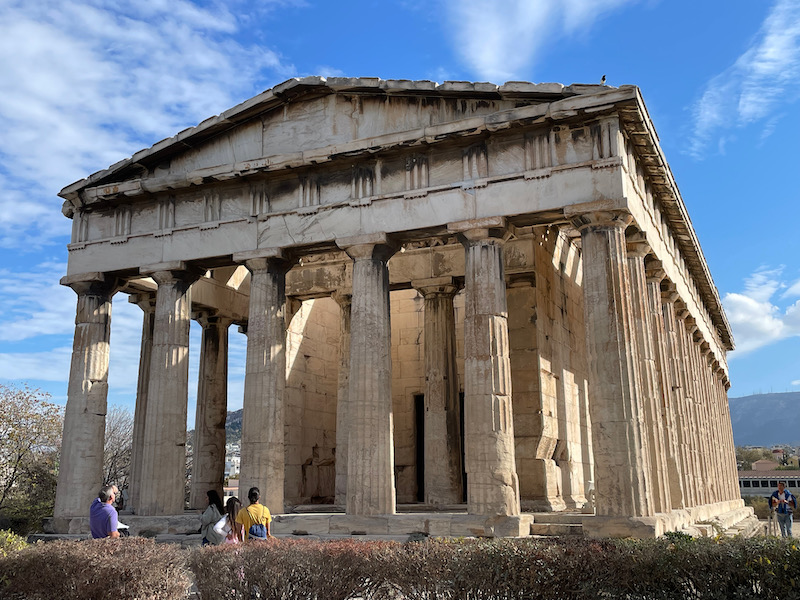
The frieze that goes around interior walls also has nice decorations, which to me looks to have scenes from the Battle of the Lapiths and the Centaurs (you can make out the centaurs with the man's torso but horse body).
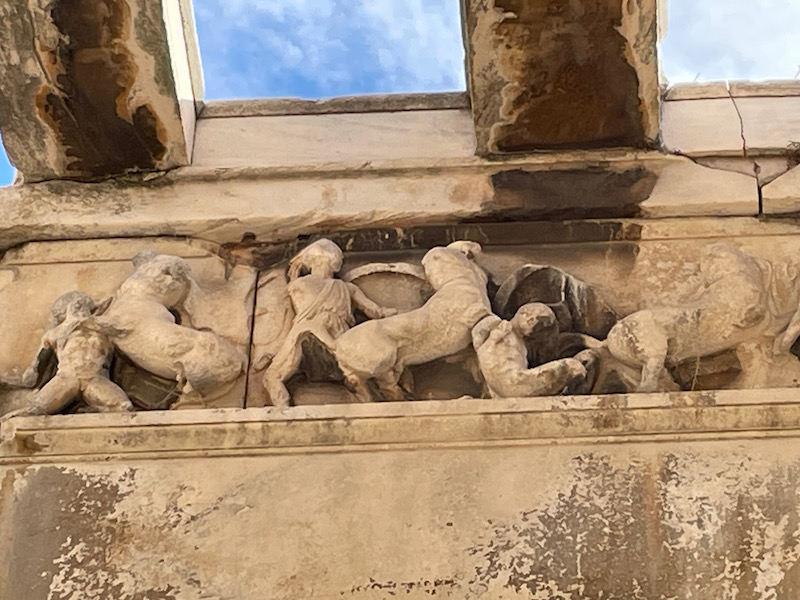
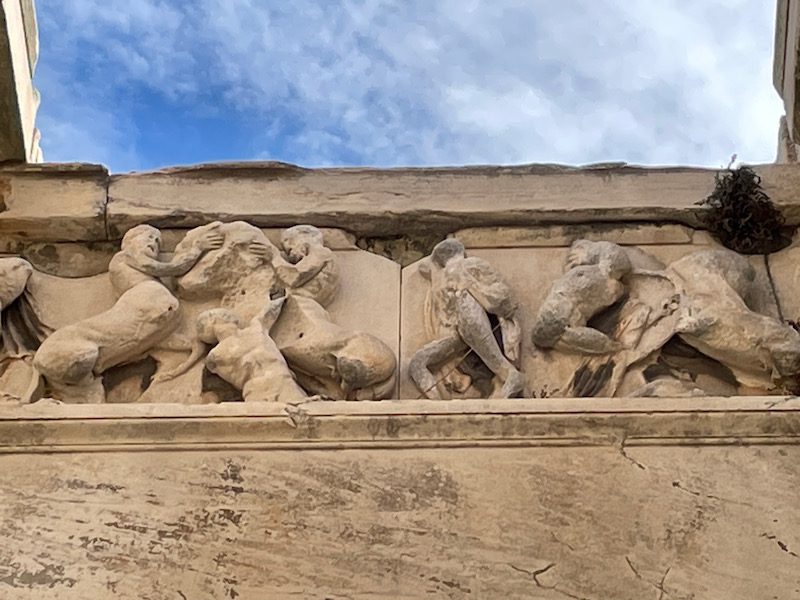
And then a few more pictures trying to get a view of the rest of the temple
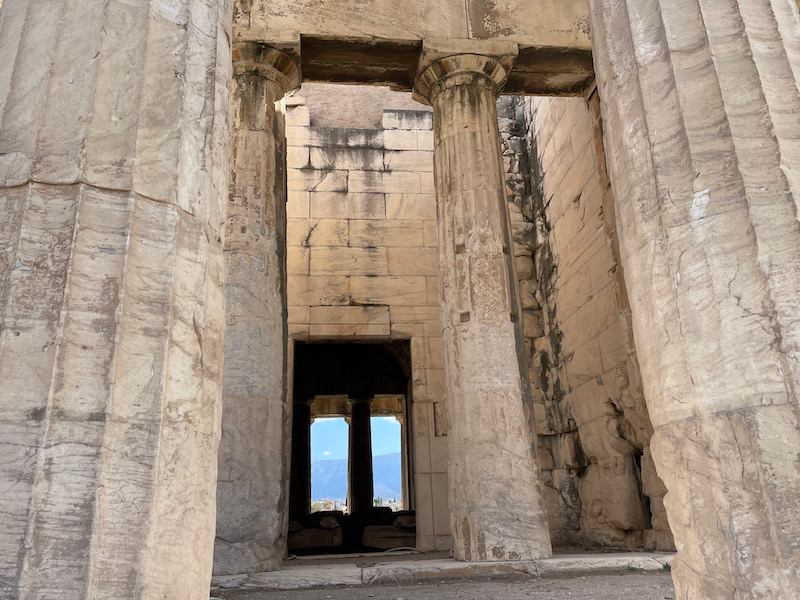
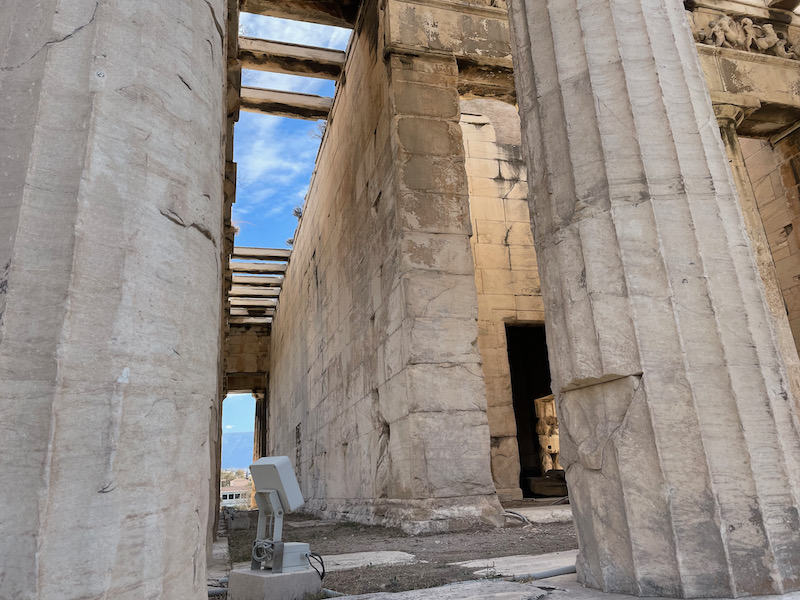
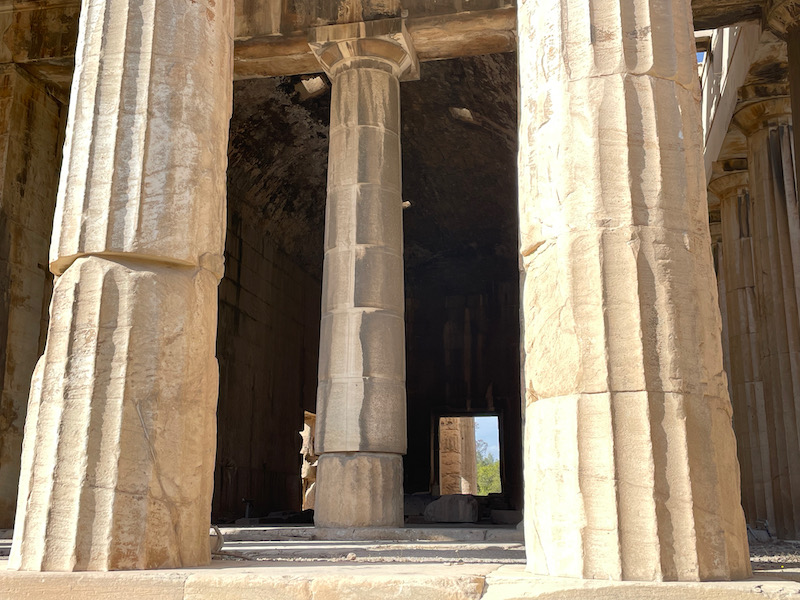
There isn't much left of the Monument of the Heroes, a marble podium that held the bronze statues of the heroes representing the tribes of Athens. The monument was surrounded by a wooden fence on stone posts. All that remains are pieces of a long statue base with the space for 10 statues and 2 tripods at the ends with a partially restored fence. You can see the places in the stone posts where the wooden pieces would have been inserted.
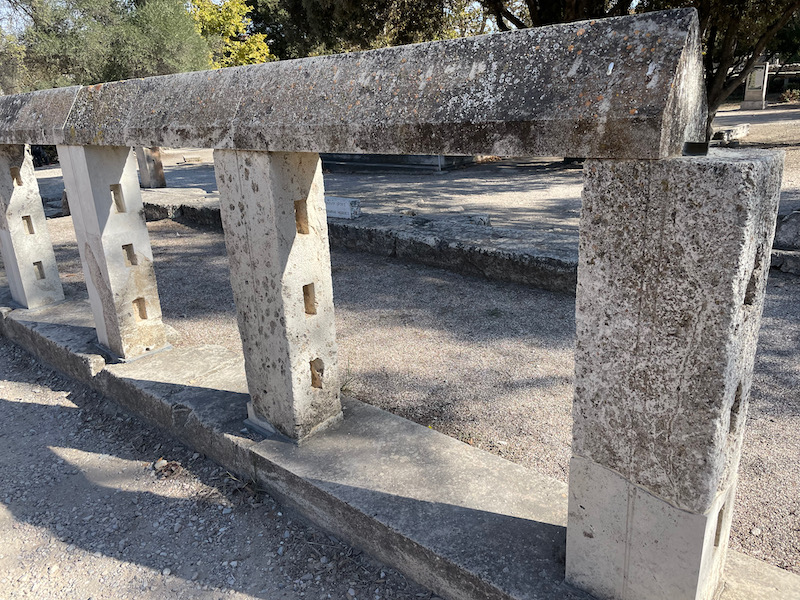
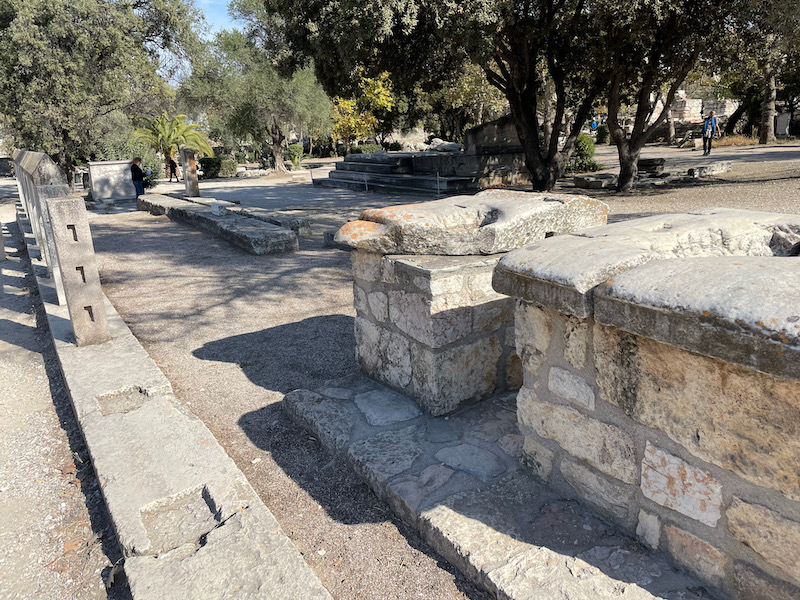
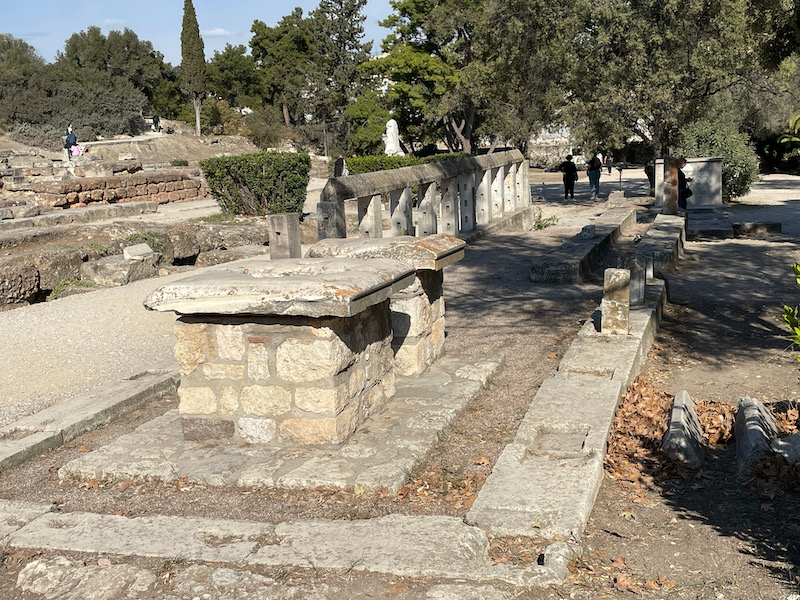
One of the rare Byzantine edifices that has retained much of its original form since the 10th century is the Church of the Holy Apostles. It was originally constructed atop a 2nd-century Nymphaeum (a monument dedicated to nymphs in classical Greece), with the purpose of commemorating Apostle Paul's teachings in the Agora. In keeping with the architectural trends of its era, the church features exterior brick decorations that mimic Arabic calligraphy. Throughout the period of Ottoman rule, it underwent several alterations, but a restoration effort conducted between 1954 and 1957 removed its 19th-century additions, returning it to its original state.
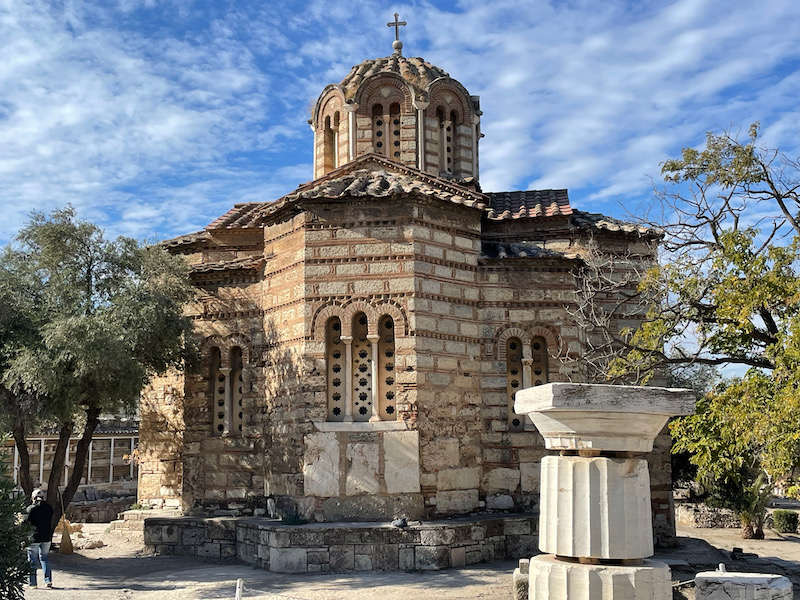
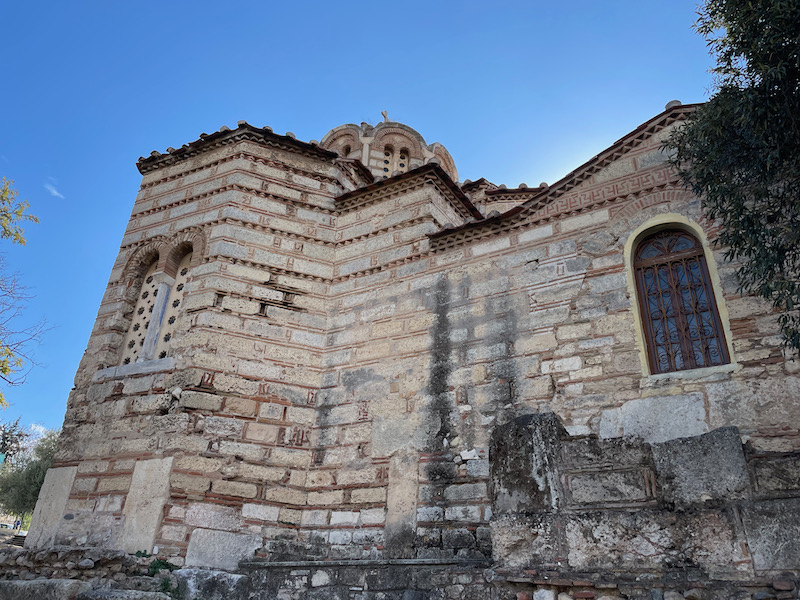
One of the more important buildings in the Agora was the Tholos, a round building that you an see the outline of here. This was the headquarters of a part of the governmental council. Because officials had to be available 24/7, a set of the the representatives would spend the night in the building.
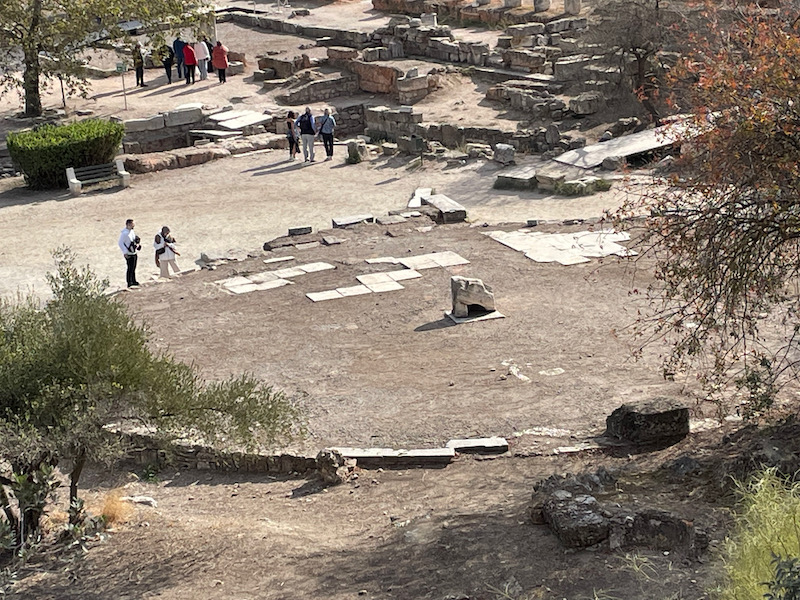
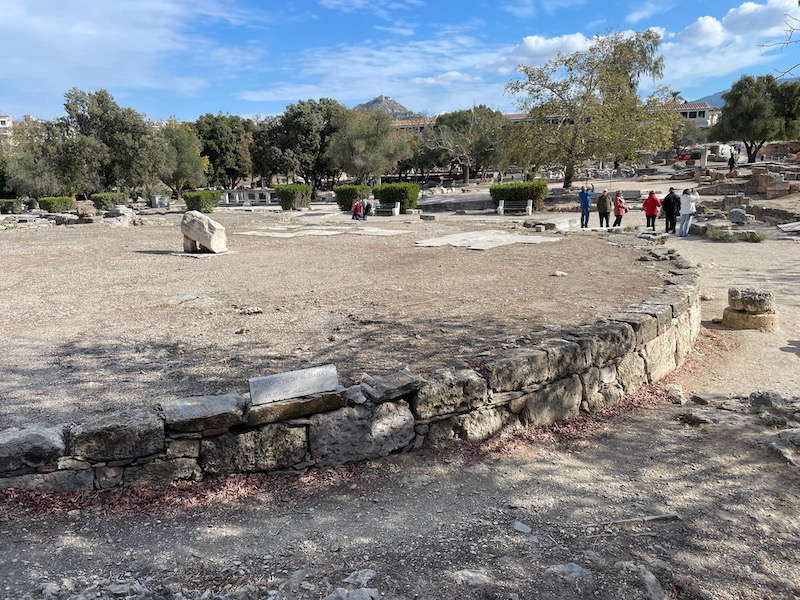
Dating from 150 B C, these big blocks are the base of the Metroon, a storage building for public documents: decrees, law codes, financial records, and legal documents.
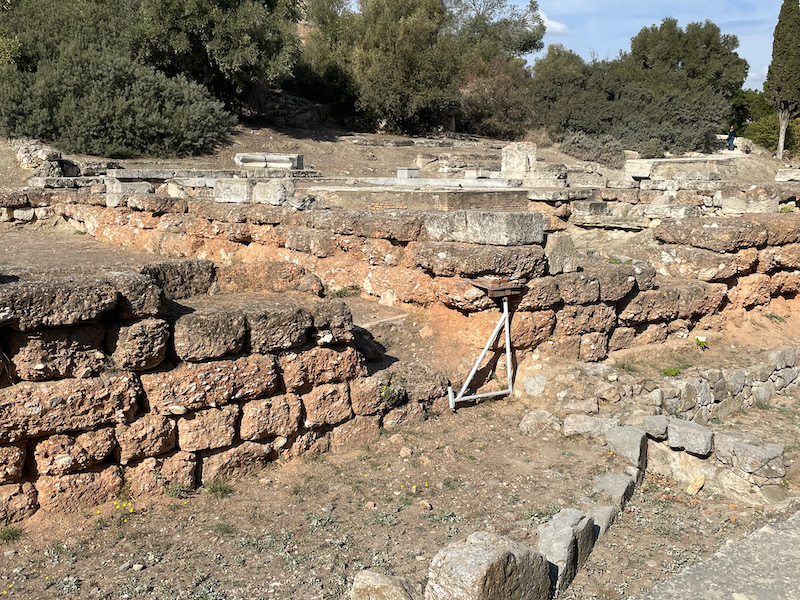
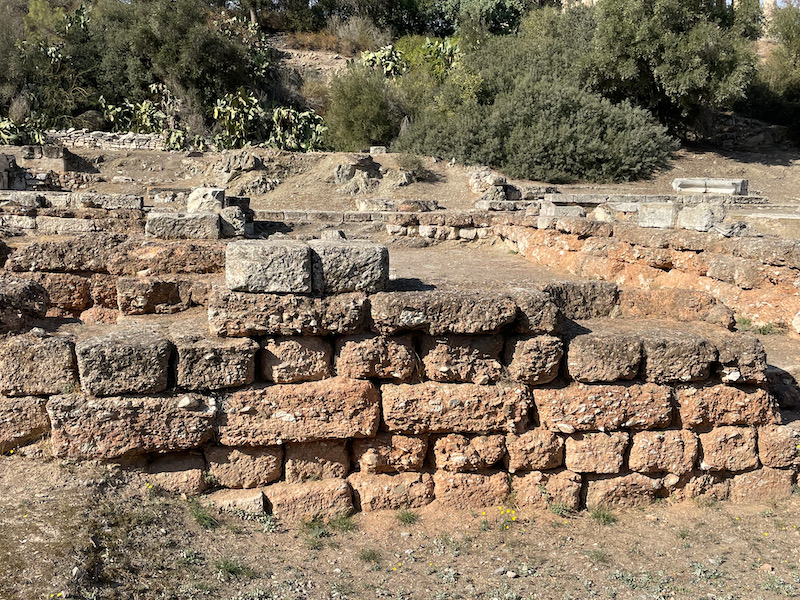
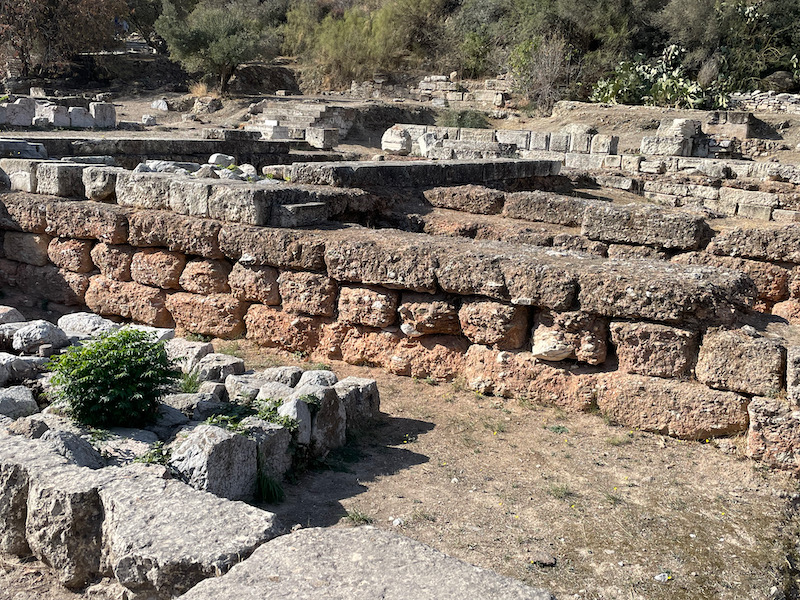
One thing I have never heard of before is a water clock. This one dates from the end of the 4th century BC and was used to determine the time within the day. A stone tank was filled with water from the nearby aqueduct. At dawn, a plug would be pulled at the base of the tank and would drain slowly out of the tank. The passing of hours would be recorded by a flotation device in the tank that would measure the level of the water as it fell throughout the day.
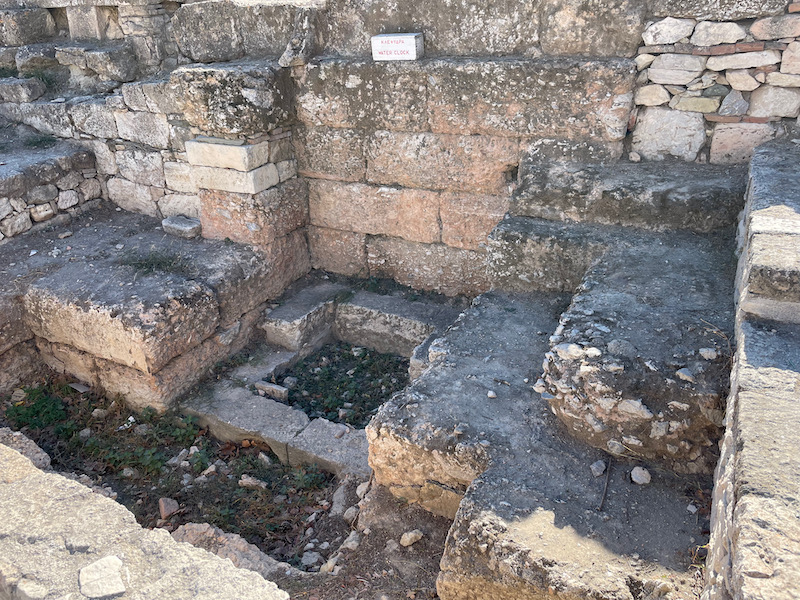
We have seen lots of columns from various buildings and temples. Some (like in Ancient Corinth) are mono-columns, meaning that the columns is made from a single piece of stone. Most are not, and are created by stacking cylinders of stone (called drums) on top of each other. You can see here the square section that is cut into the stone. You put one cylinder down and put a metal (most likely bronze) square peg into the hole. Then you place the next cylinder down on top of the square metal peg, which keeps them together. Mind you ... this didn't keep the columns from falling down during earthquakes, which seems to have been a temple's worst nightmare.
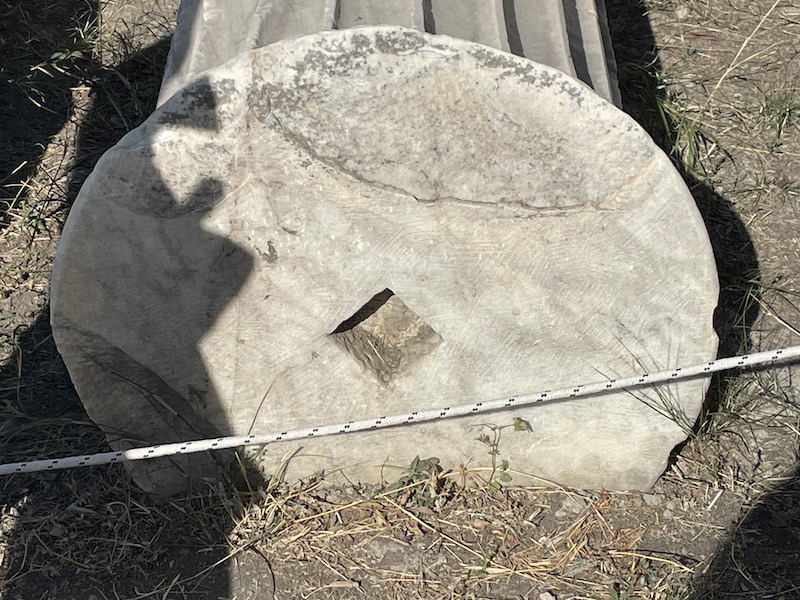
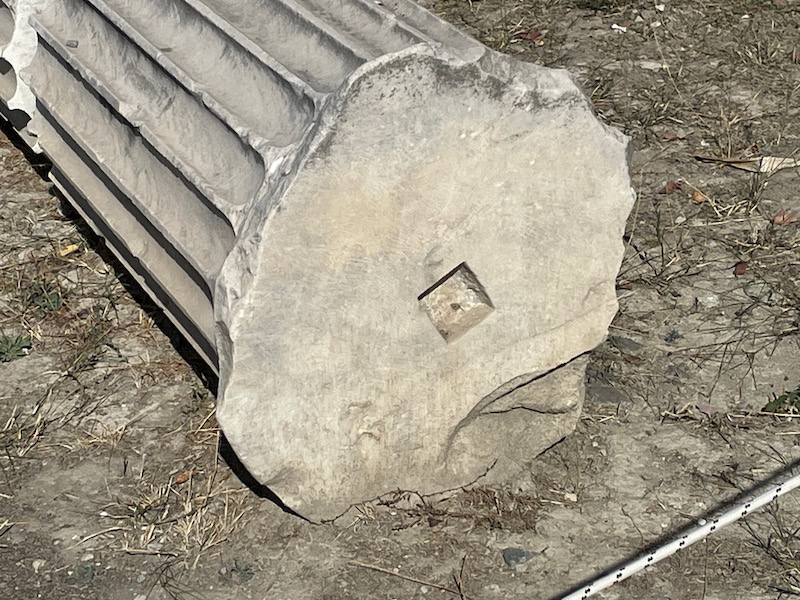
Just in front of the museum was this piece, which came from a small circular building. The interesting thing for me here is the decoration chiseled into the stone, including the heads of lions (I know, the 2D picture doesn't do the lion head justice).
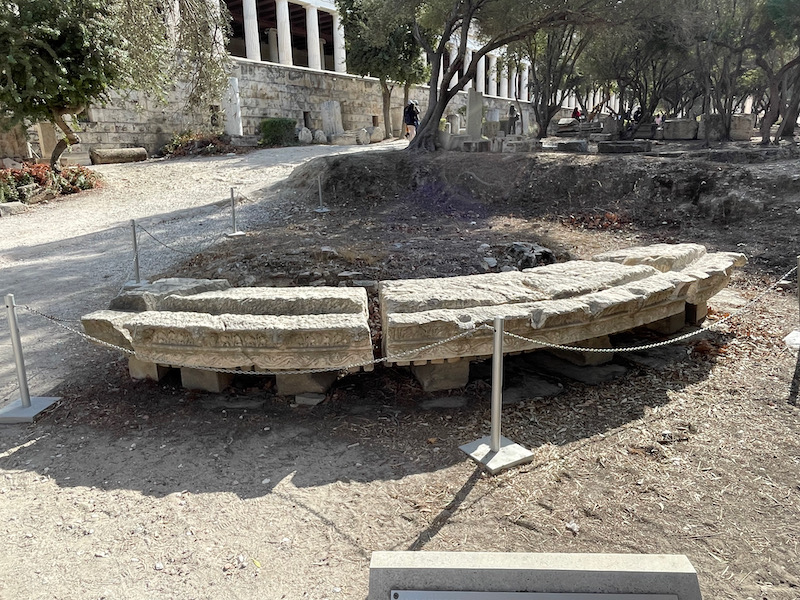
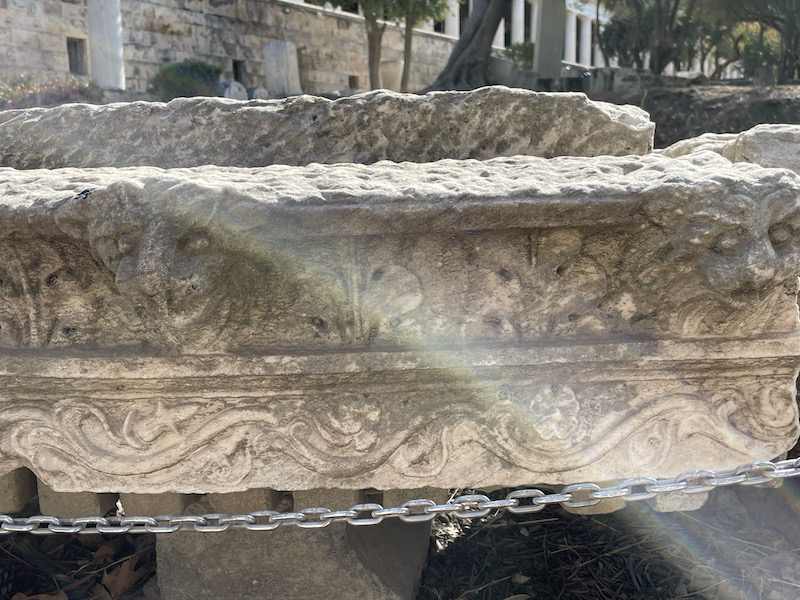
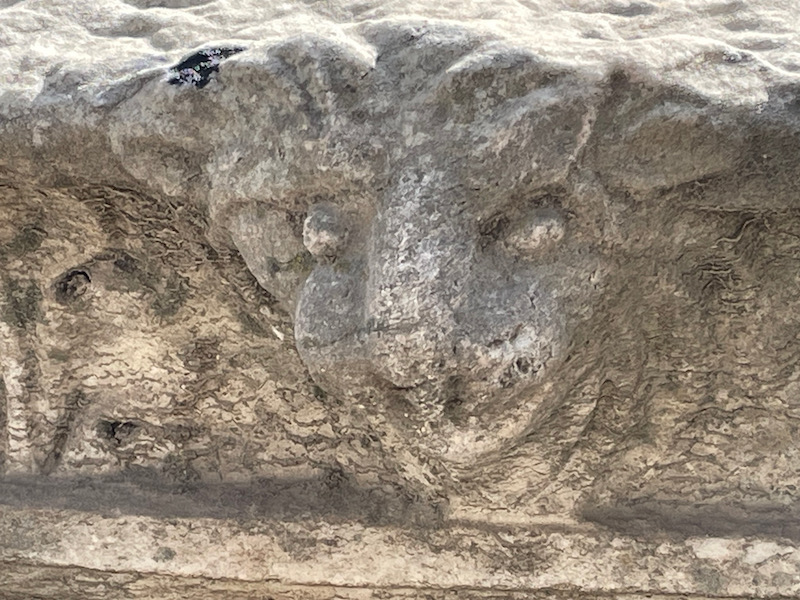
The Museum of the Ancient Agora is housed in a reconstruction of the Stoa of Attalos. A "stoa" is a rectangular building with a columned façade and we saw them in a variety of sites. Named after King Attalos II of Pergamon in present-day Turkey, this stoa was offered to Athens as a gift during his reign in the 2nd century BC. It was ruined, like most things here, but totally rebuilt in the 1950's to house the museum. Seeing this across the Agora, you can imagine how impressive all of the other buildings here would have been.
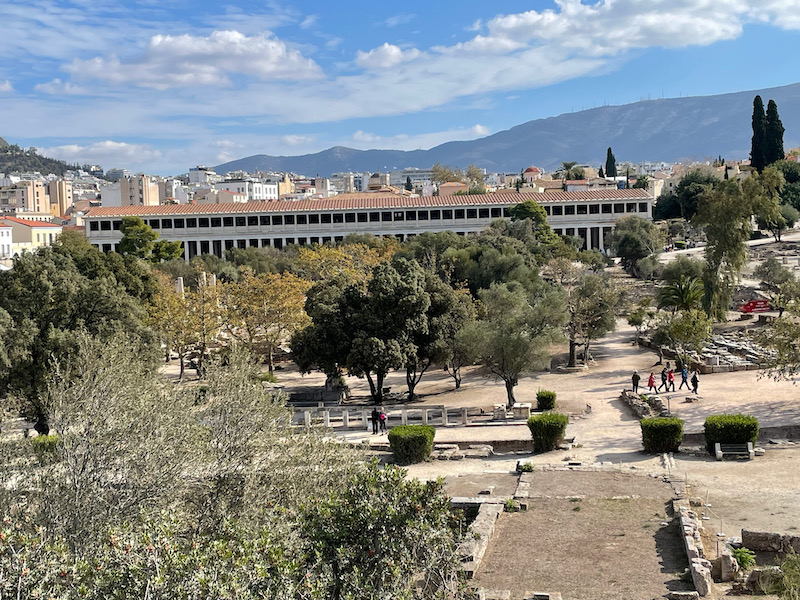
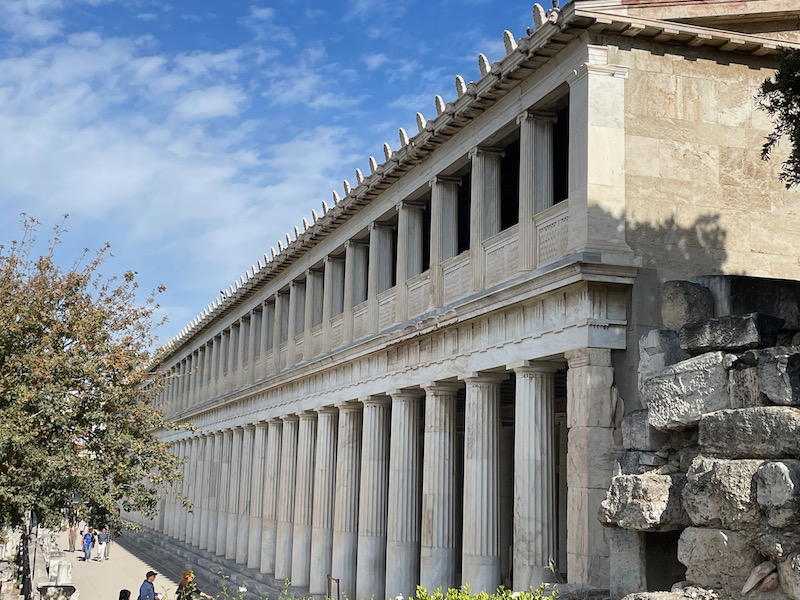
The museum itself is much smaller than I thought it would be. It showcases artifacts discovered in the Agora site, spanning from the early Neolithic period to the Roman occupation and Byzantine era. I picked just a few things that I thought were the most interesting. First up is the grave of a little girl from around 1000 BC that was found underneath the museum building. The body was laid out on its back with the head to the South. There were a few pieces of jewelry and pieces of pottery decorated with geometric designs. The grave was protected with a layer of flat field stones, which is why these pottery pieces were not too terribly damaged.
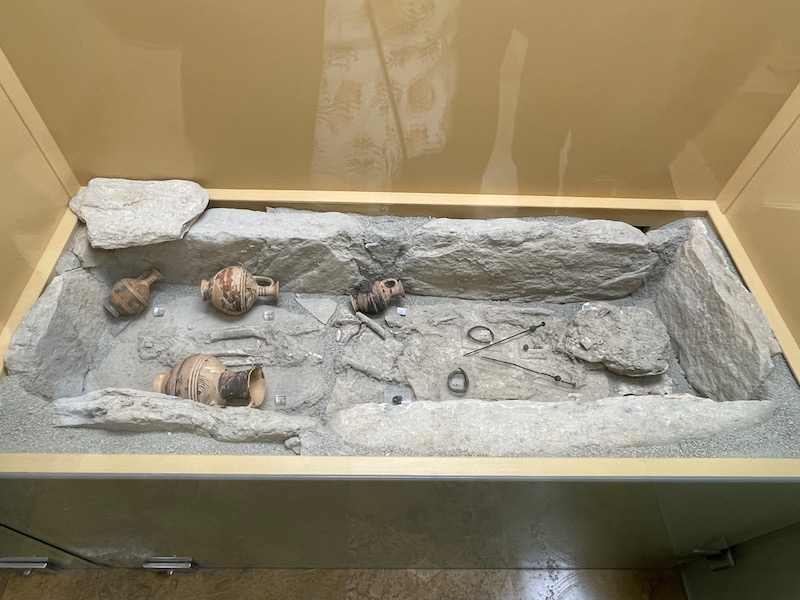
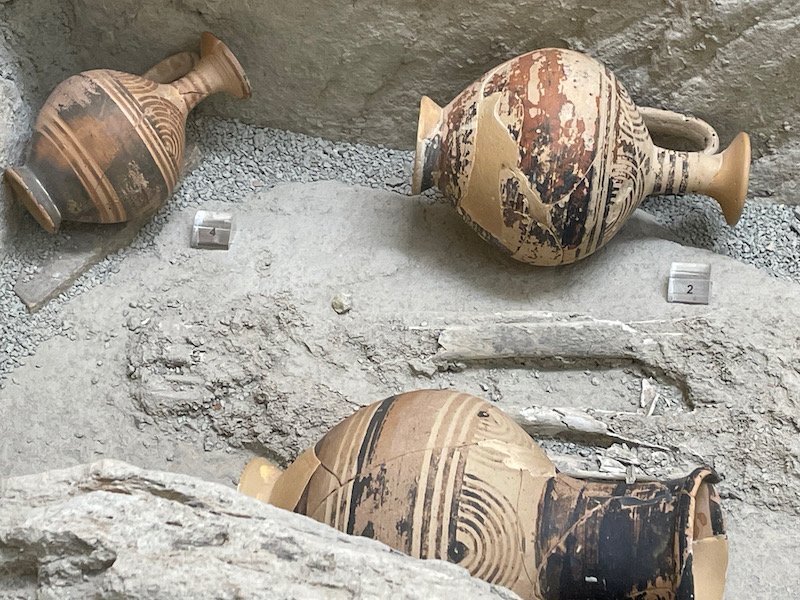
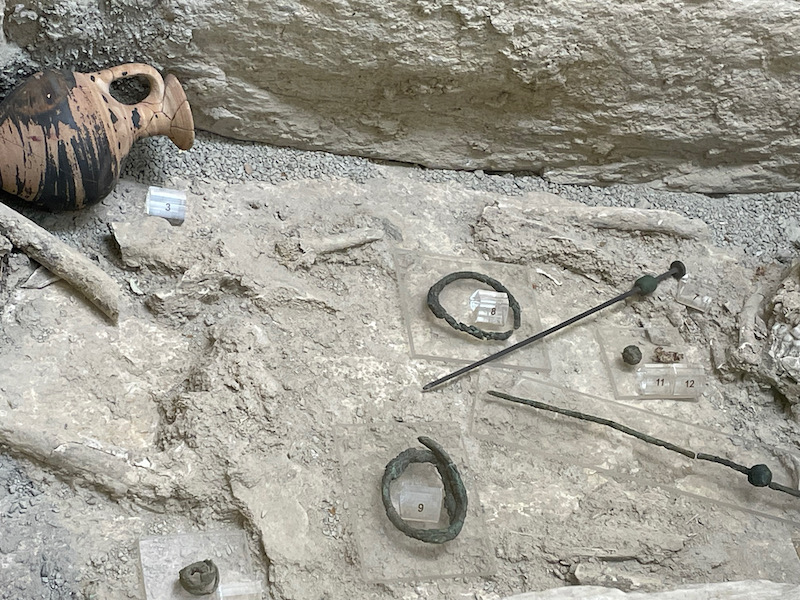
I wanted to show a progression of the designs of pottery through time ... from the late 9th century BC are these pieces found in another grave. They are from the "Middle Geometric Period" and you can see how the painted design are geometric shapes.
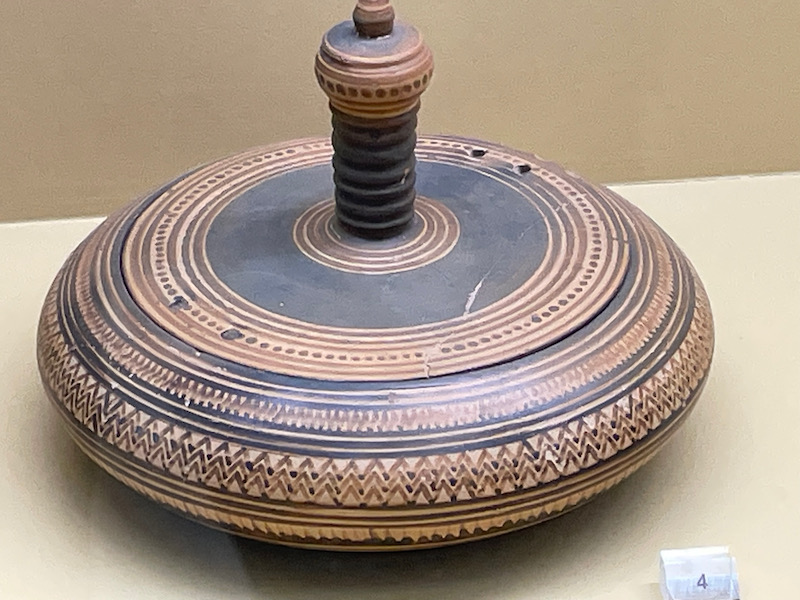
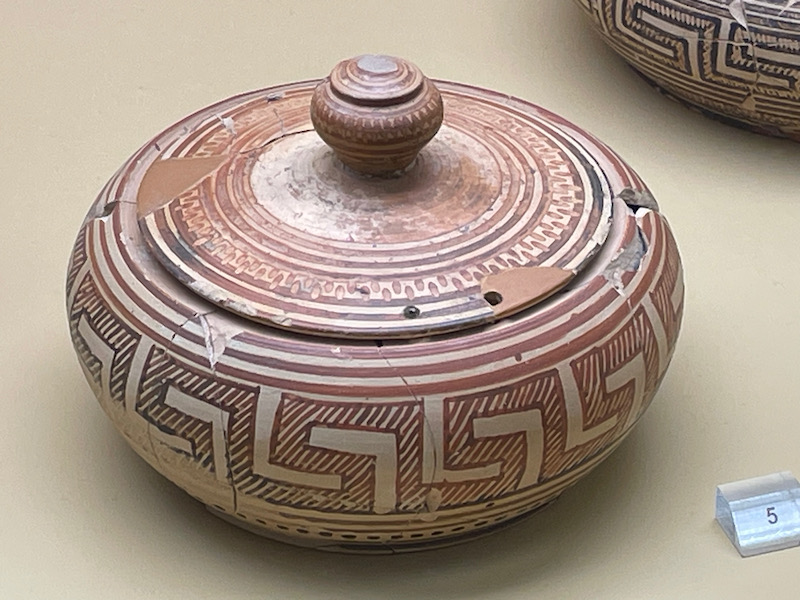
We saw these in the museum in Ancient Corinth as well ... Black Figure pottery from the 6th century BC, where there the figures of people (or animals) are shown in black on an orange background. Then in the 5th century BC, Red Figured pottery was introduced, which flips the colors so the figures are in orange (they call that color red for some reason) and the background is black.
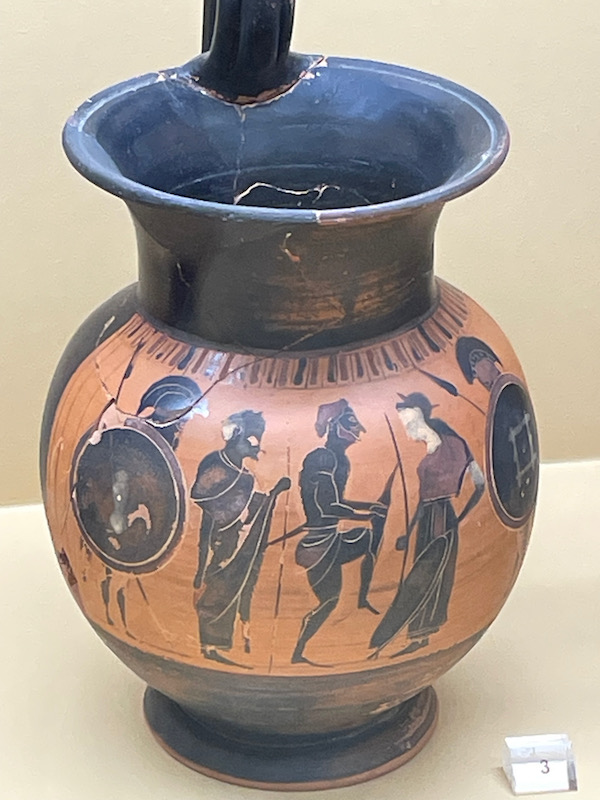
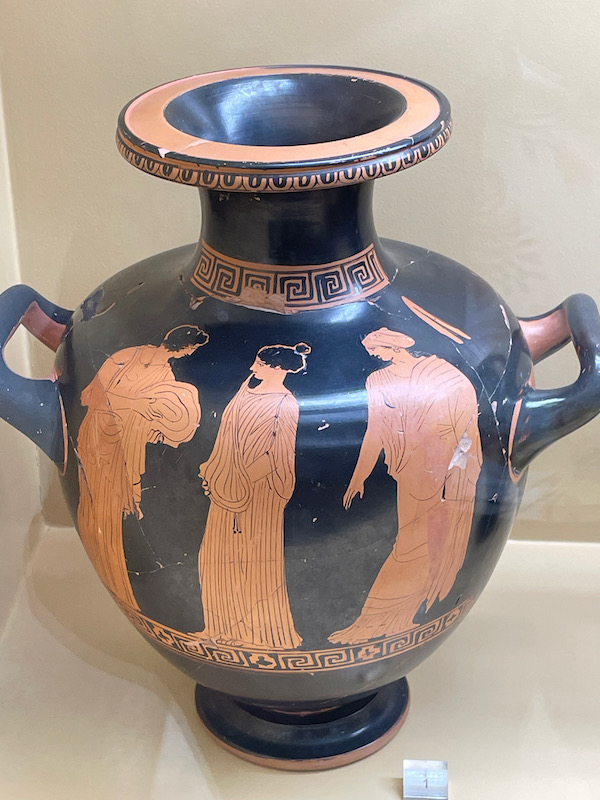
One thing I had never seen before are these "voting disks", that were used in the process of "ostracizing" someone. During annual assemblies of citizens to decide the faith of wrongdoers, each voter would these scratch (or paint) the name of the man he thought was most undesirable. The individual with the most votes would face banishment or "ostracism" from the city for 10 years. These specific ostraka were created for the ostracism of a man named Themistocles in 482 BC.
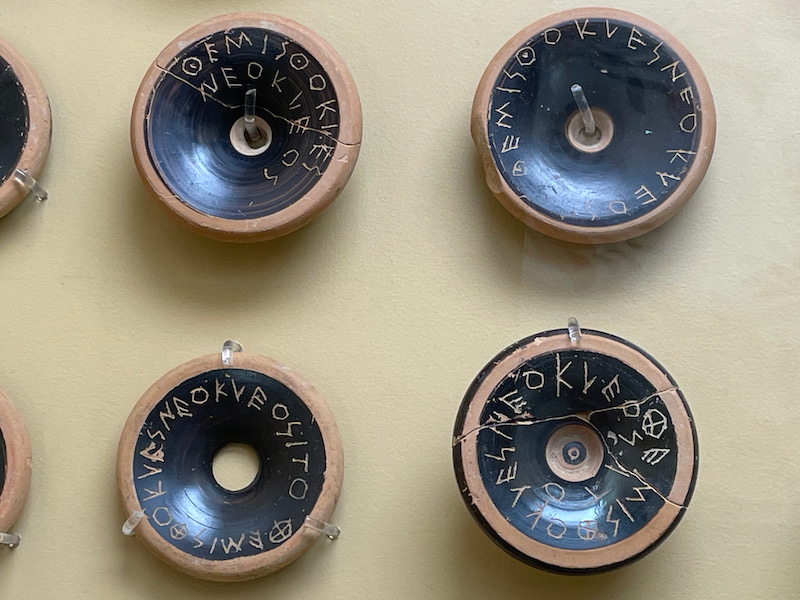
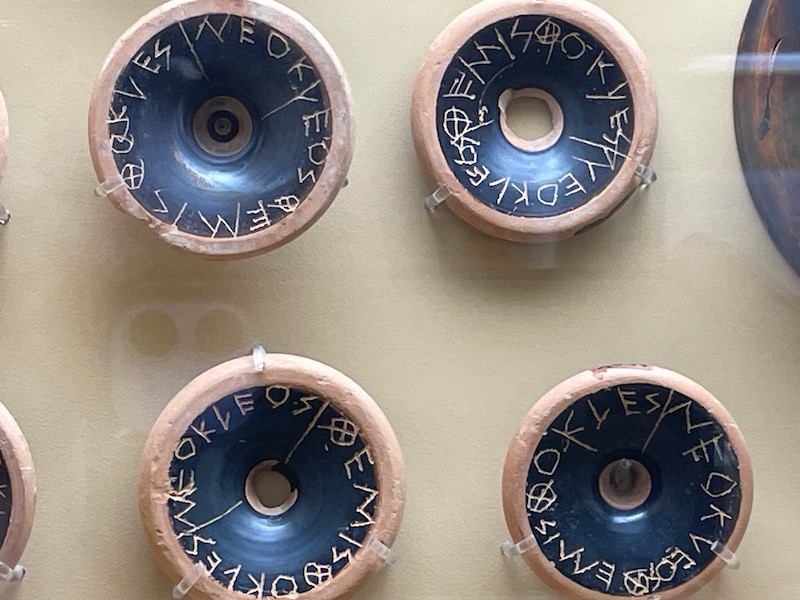
At the end of the 1st century BC, Marcus Vipsanius Agrippa, son-in-law of the Emperor Augustus, built the Odeon of Agrippa. Agrippa was a Roman General most known for his victory at the Battle of Actium in 31BC when his forces defeated Mark Antony and Cleopatra, after which both of them committed suicide. This was a huge building with a stage and auditorium that was designed for musical performances. On one side were 6 columns with colossal statues of Tritons and Giants. There are some pieces of these giant statues and one of the corinthian capitals.
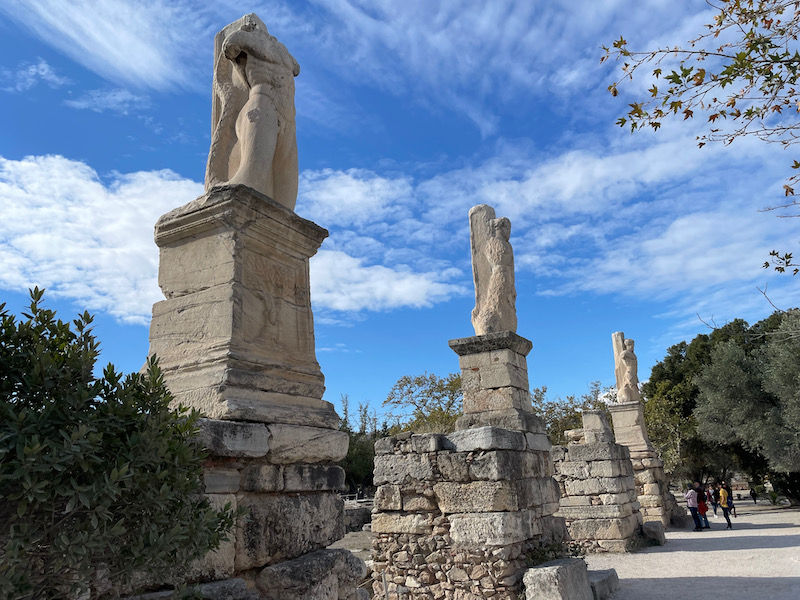
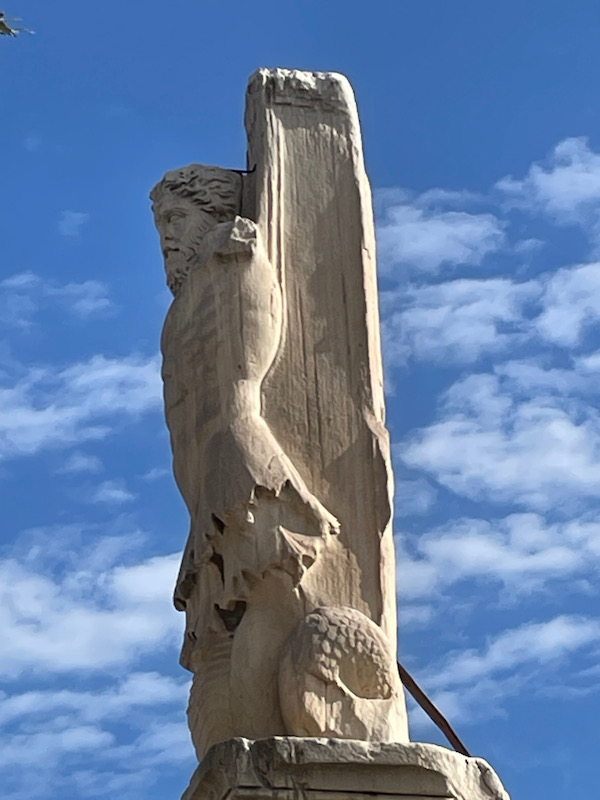
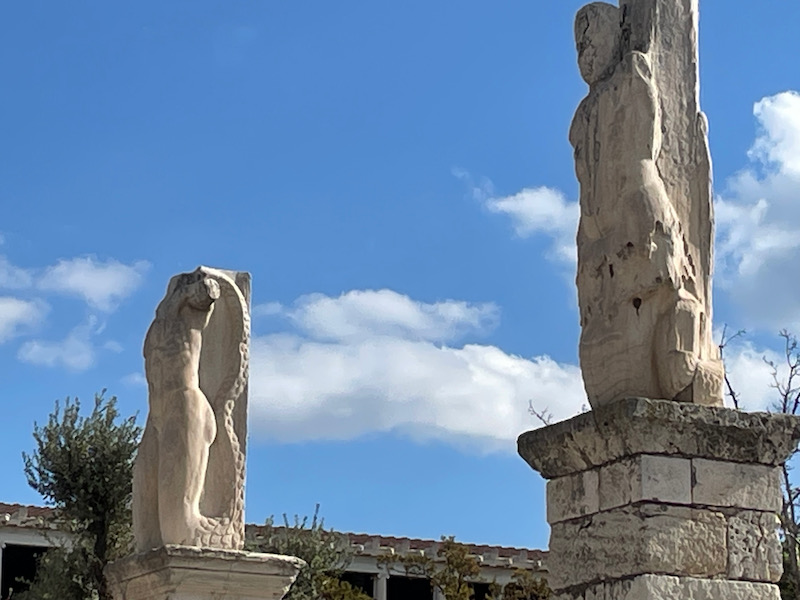
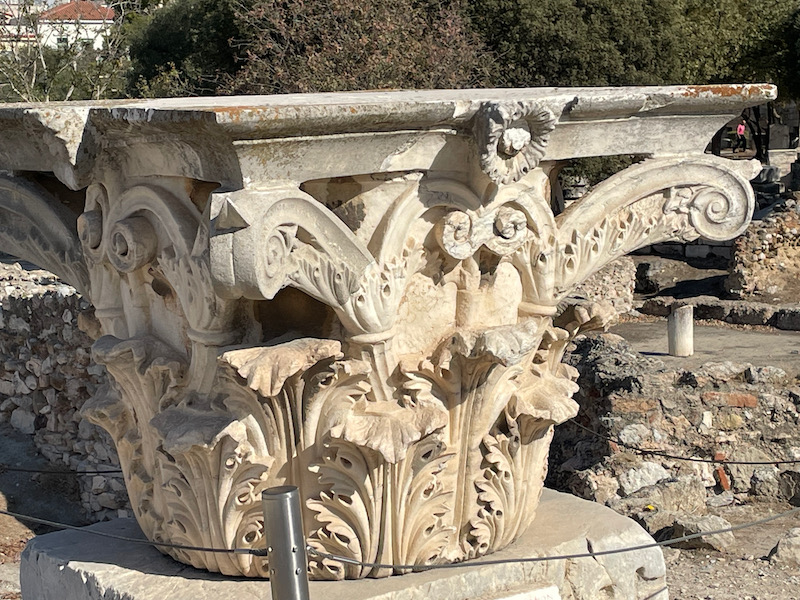
From the Ancient Greek Agora, we move 100 meters east to the Roman Agora. During the reign of Augustus, commercial activity was no longer allowed in the ancient agora and so a new one was built, known as the Agora of Caesar and Augustus (or simply the Roman Agora). So around 17 BC, the business activity moved to the new agora, leaving the old agora as a center for the various cults. We didn't go into the Roman Agora but peeked at a few things from the perimeter. The main gate is the Gate of Athena Archegetis and behind that, you can see the remains of a set of different buildings.
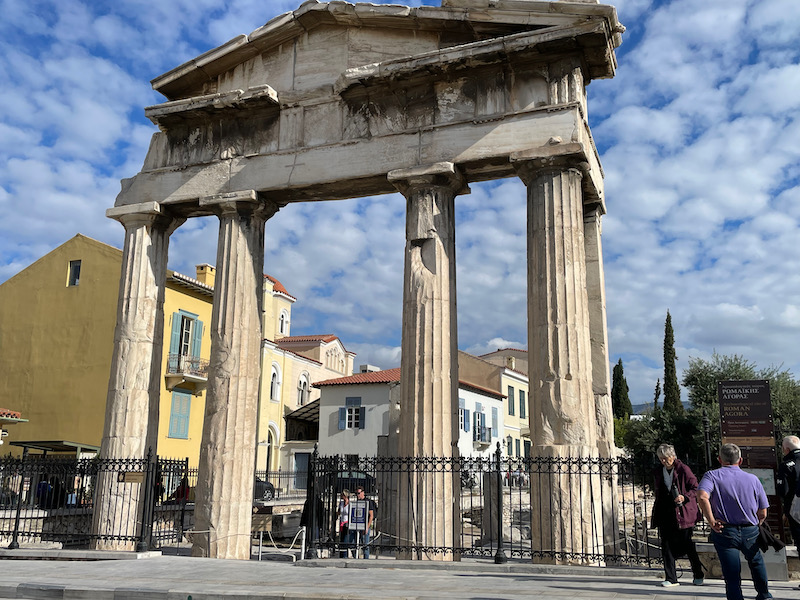
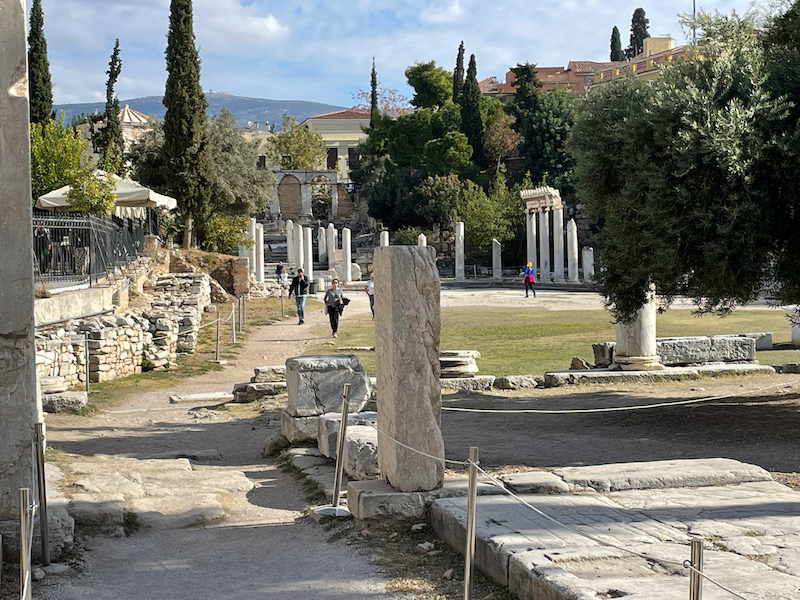
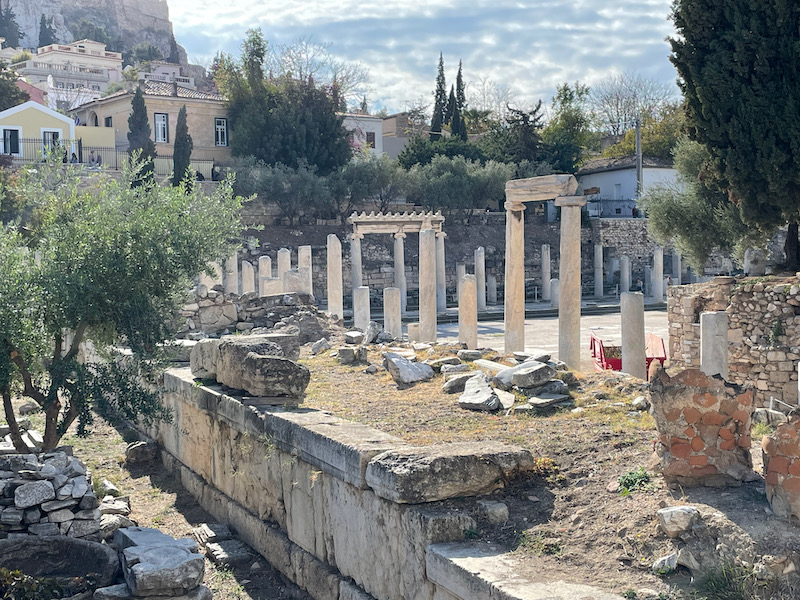
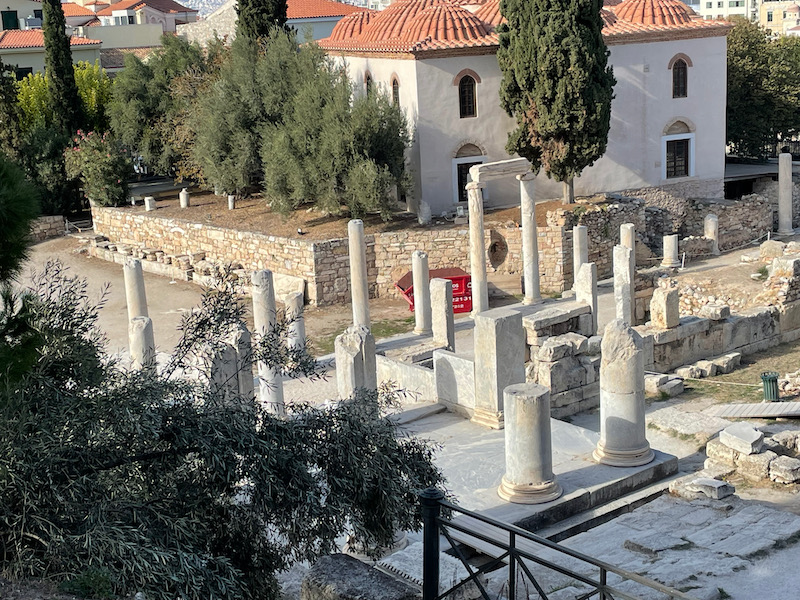
The most remarkable structure within the Roman Agora is the Tower of the Winds, a 12-meter-tall octagonal marble tower. At the top are carved the 8 wind deities: Boreas (North), Kaikias (Northeast), Apeliotes (East), Eurus (Southeast), Notus (South), Lips (Southwest), Zephyrus (West), and Skiron (Northwest).
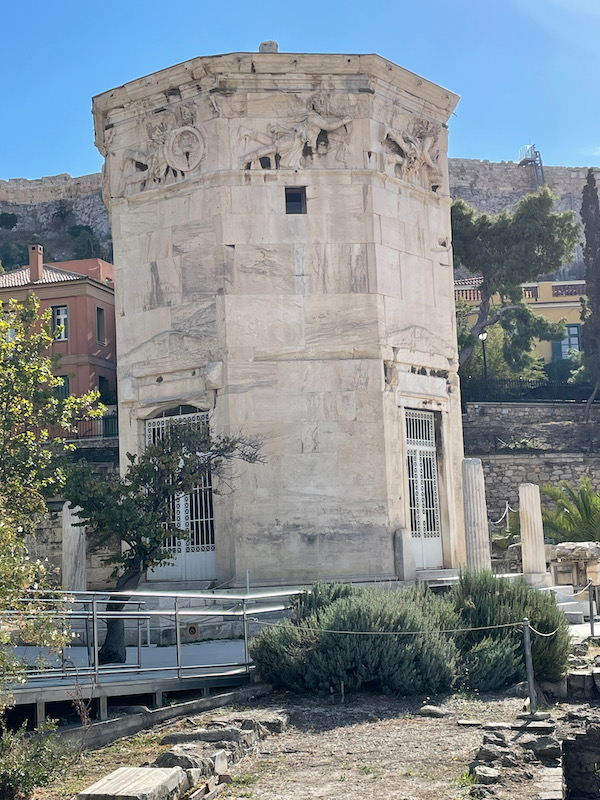
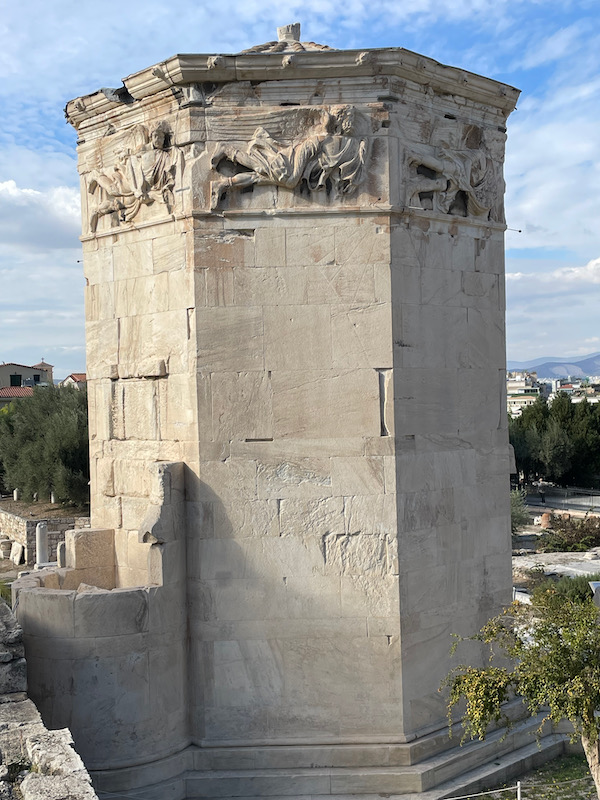
I have never heard of the 8 wind dieties but Wikipedia actually talks about them. The one on the right-hand-side of the first picture is Kaikias, the north-east wind that is cloudy, wet and cold, with snow and hail. You can make out that a shield, which contains hail. The left-side is Apeliotes, the east wind, who brings a gradual gentle rain, and is a great friend to vegetation. You can see the cloak full of fruits and cereal crops. The 2nd picture is a little closer view of Apeliotes.
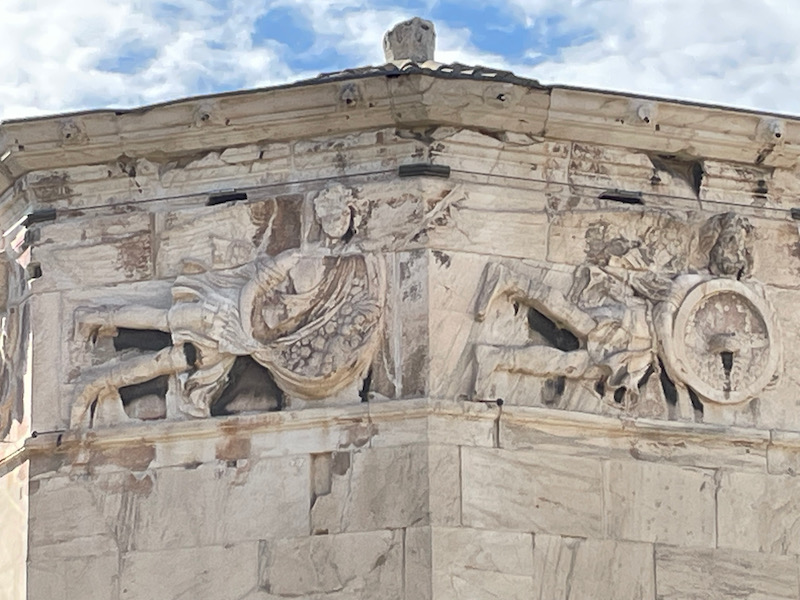
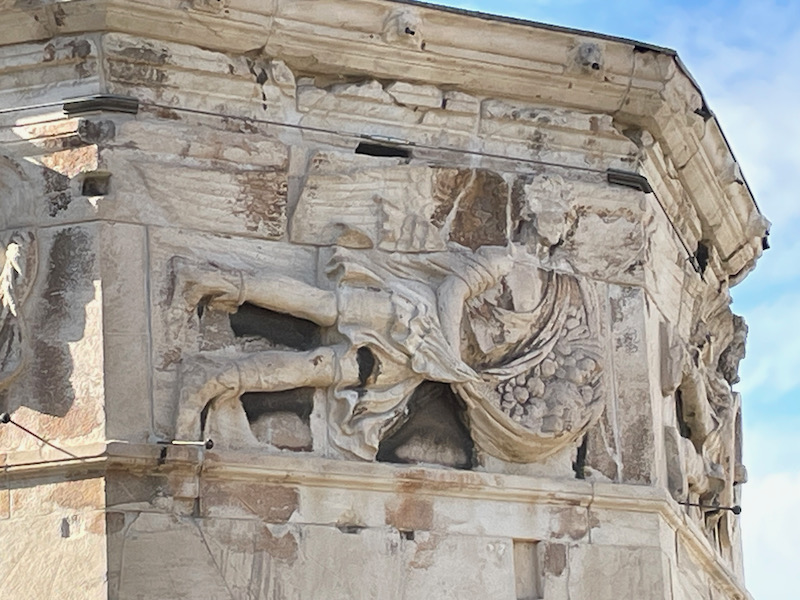
Eurus, the south east wind that brings rain. He has a bearded face, wings, and a cloak.
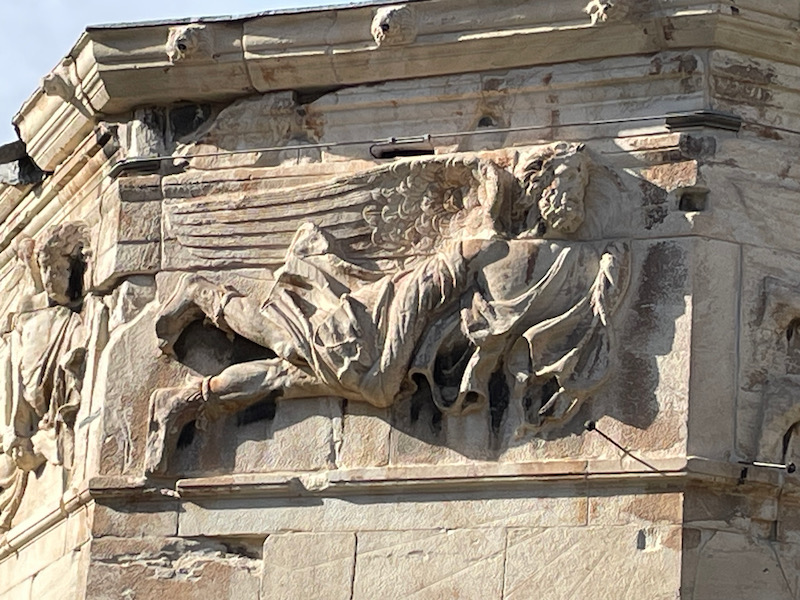
The last 2 I got a picture of are Libs on the left, the south-west wind that blows directly across the Saronic Gulf and is shown barefoot with a ships representing shipwrecks, and Notus on the right, the south wind that brings lots of rain and has an upturned jug (supposedly pouring out the rain).
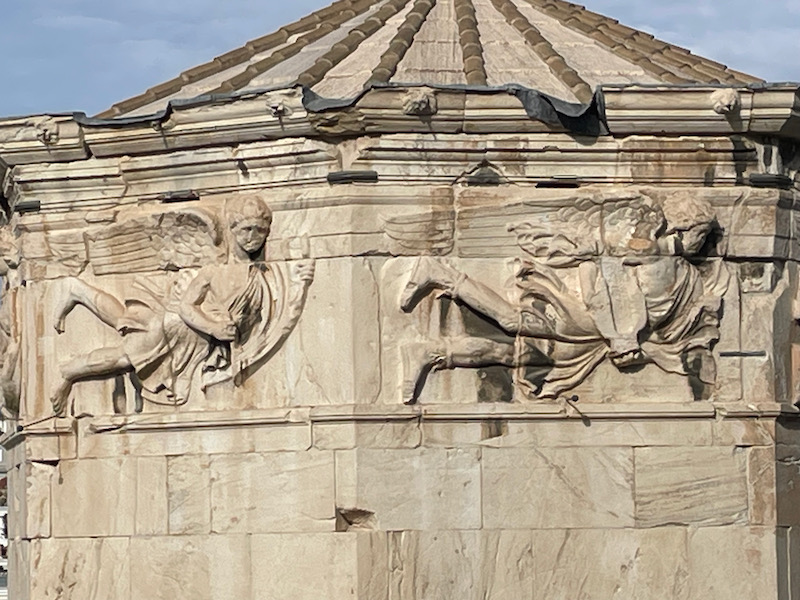
Now we move to something more recent, the Benizelos Mansion. I mentioned that the Cathedral contains the relics of Saint Philothei, who was the daughter of a prominent family, the Benizelos family who owned this house. It is an excellently restored Ottoman-era house, dating back to the 16th or 17th century. This type of urban aristocratic residence is called a 'konaki' and this is one of the last remaining examples of this type of house. There are several exhibitions and displays that recount the story of the family. On the first floor is a loggia supported by pillars, which was later enclosed with glass. The mansion's courtyard is enveloped by tall walls, characteristic of Athenian residences from that time period, and would have contained a garden and fruit trees.
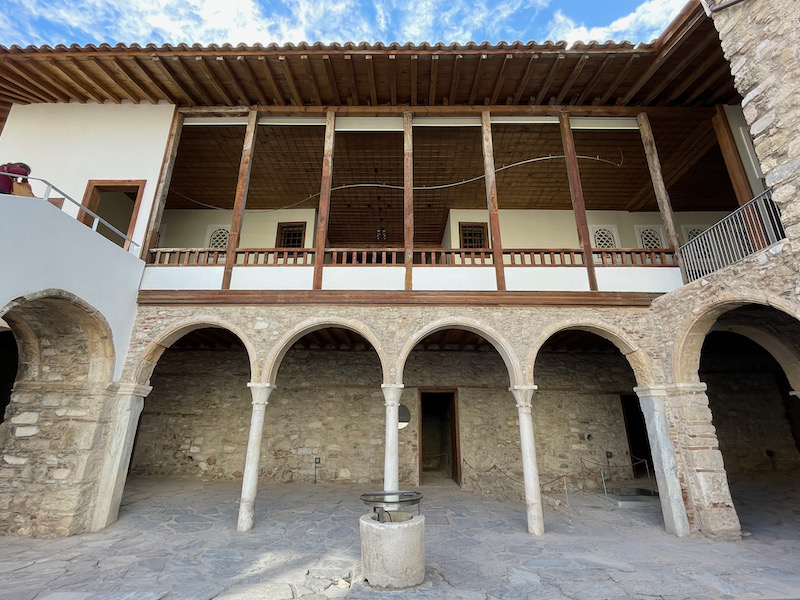
The ground floor had the "working" rooms, including rooms that contained these large pottery containers that would have held wine, grains, and olive oil.
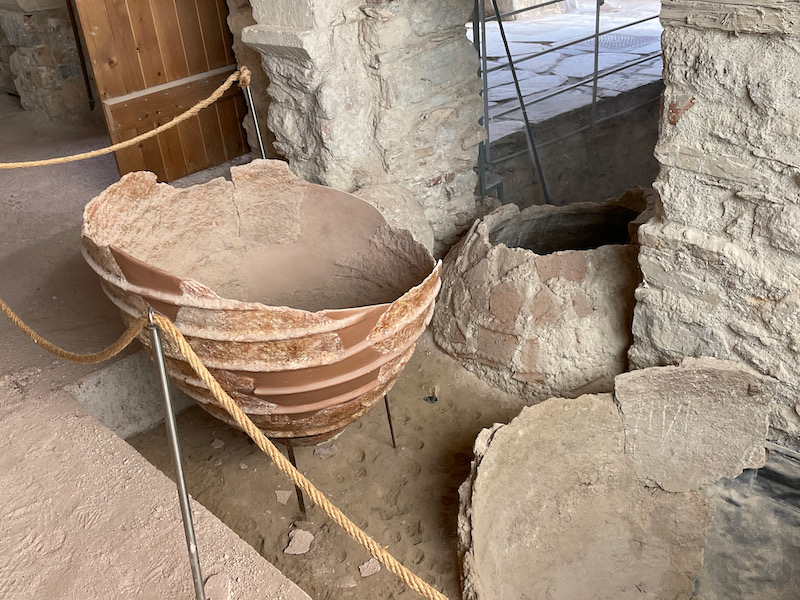
The upper floor is split into a couple almost identical rooms, one of which had a fireplace at one end. The various residential spaces seemed to be rather sparse, with raised benches that went all around the rooms in a U-shape, with cushions placed on them. The doorways to each of these rooms had a nicely carved archway.
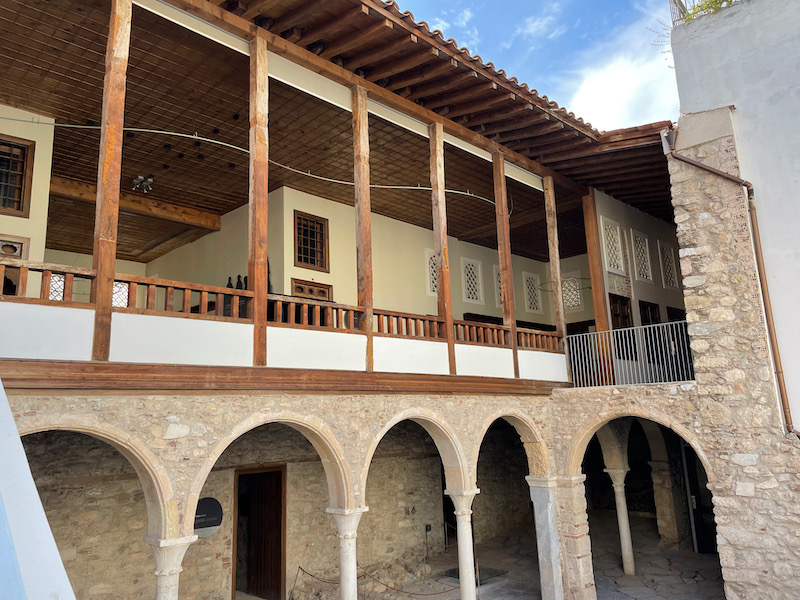
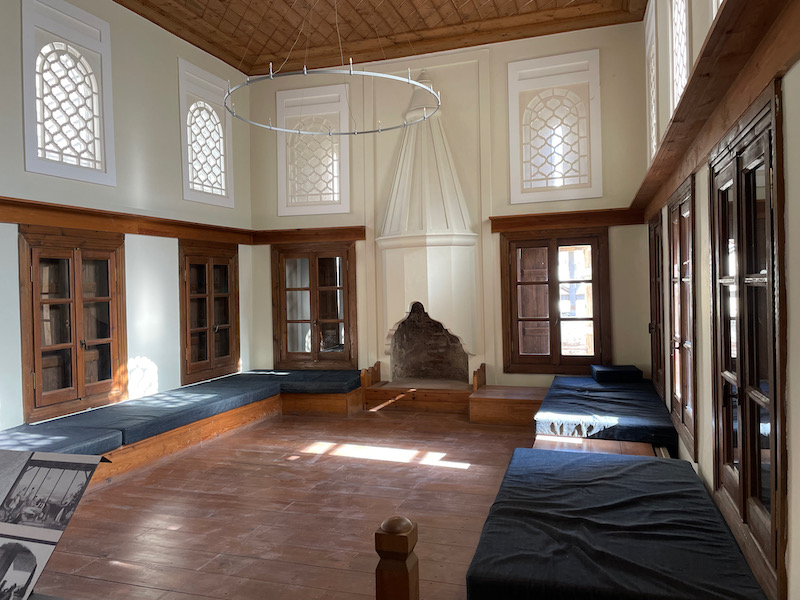
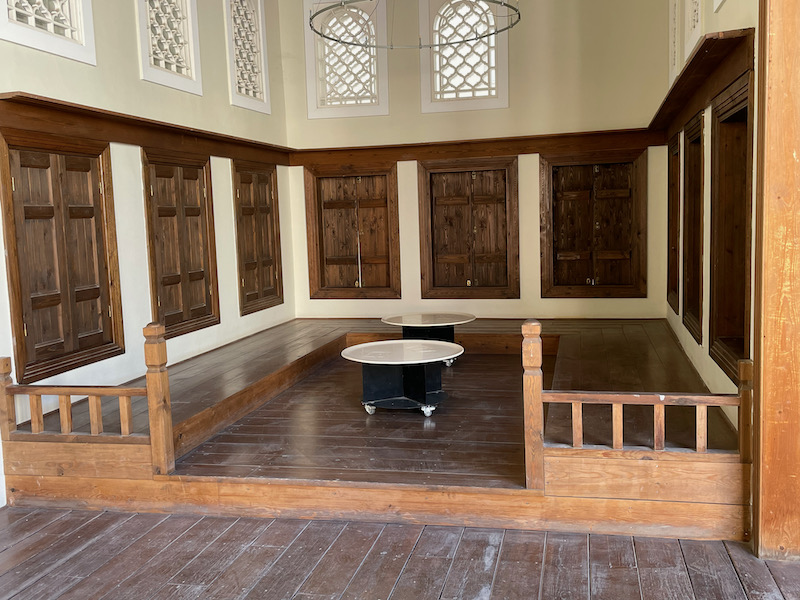
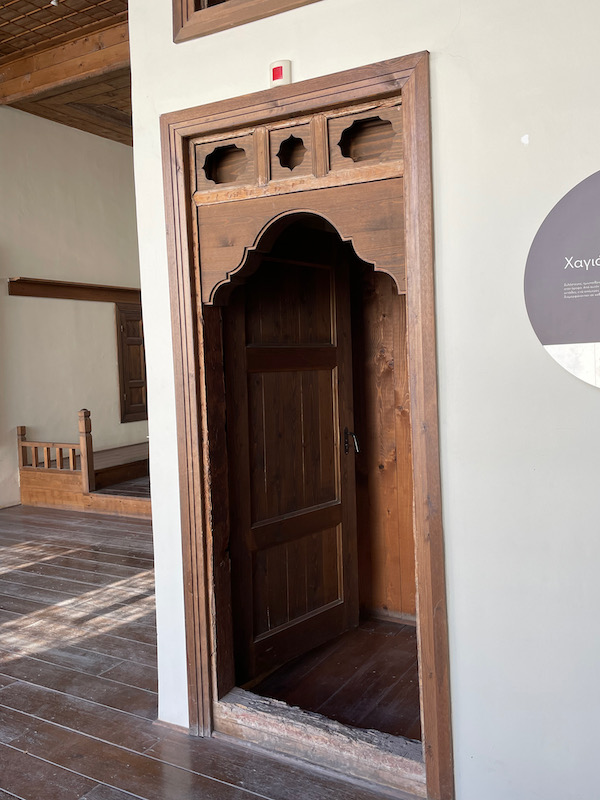
From the back, you can somewhat see the middle section that jutted out further than the other 2 residential rooms.
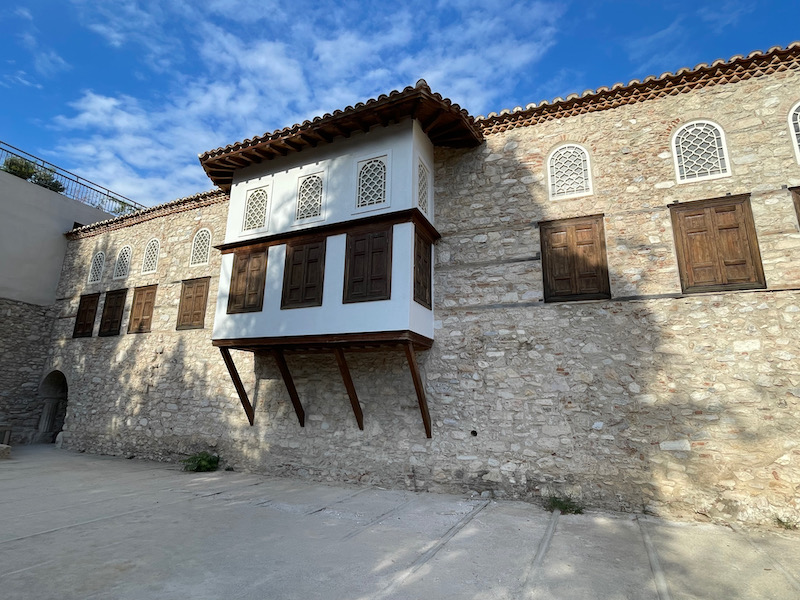
Walking through the Plaka, which is a fashionable eating-and-drinking area on the slopes of the Acropolis, we came around the Holy Church of Saint Nicholas Rangavas. This is another Greek Orthodox church with Byzantine architecture that dates back to the second half of the 11th century AD. Like some of the churches in Athens, it wasn't open when we went by.
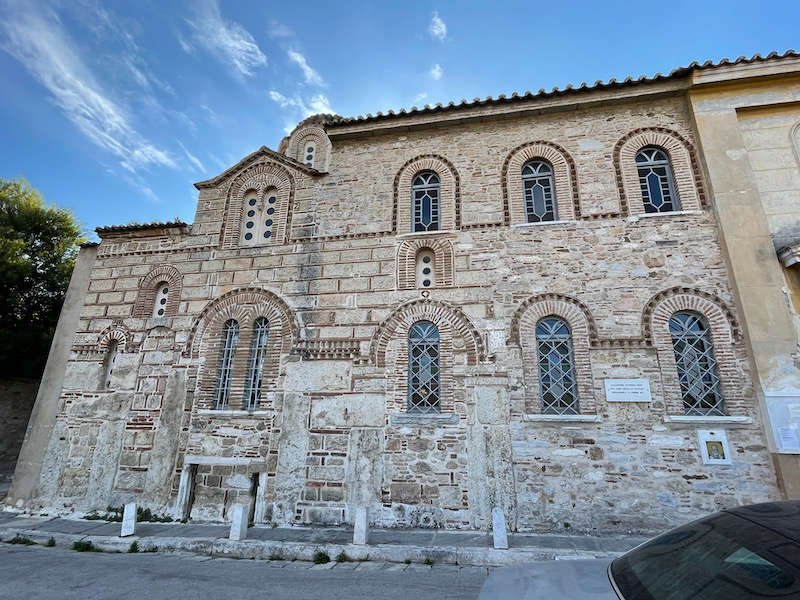
The Lysikrates Choregic Monument was built in around 334 BC. It is a small circular building that rests on a square podium. There are 6 Corinthian columns with marble panels between them. The frieze around the top depicts scenes from the life of Dionysus. In 1669, it was incorporated into a monastery that was destroyed in 1824, leaving the monument intact.
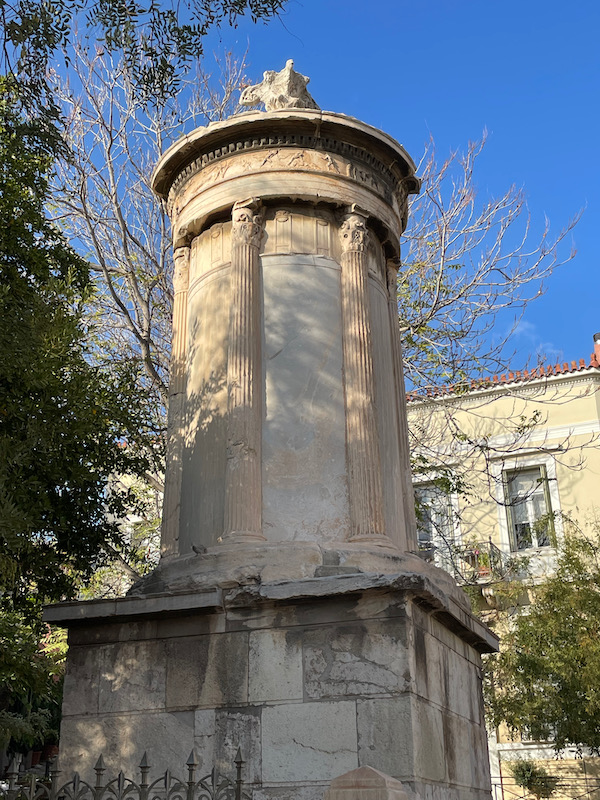
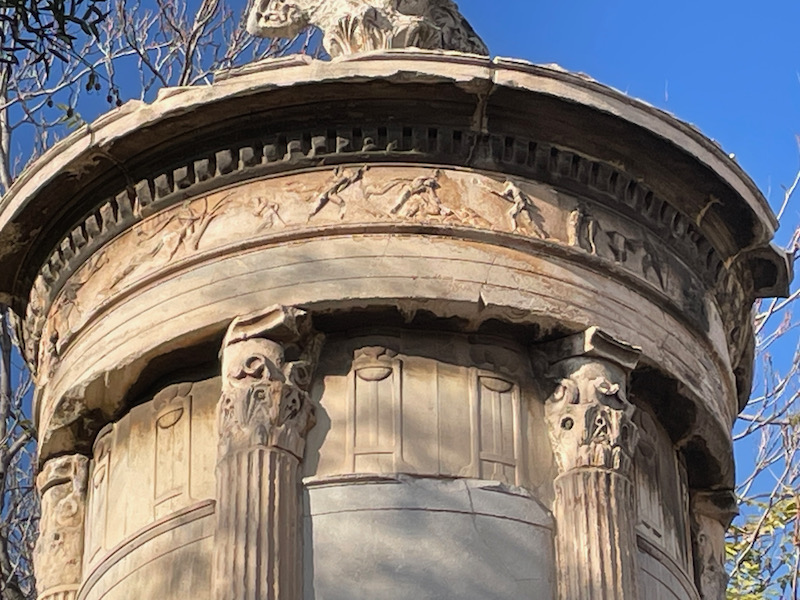
This doorway, called the Old Madrasa Gate, is all that remains of the Ottoman-era Islamic Madrasa (Theological School). The school was built in 1721 until being moved to another location. The site then housed an overcrowded prison where hundreds were executed, while the other prisoners were subjected to torture (not a happy story). It was finally closed at the start of the 20th century and the Archaeology Department began demolition in search of older and more important artifacts. By 1915, all that remained was the main door and a small portion of the adjacent exterior walls, most of which can be seen today.
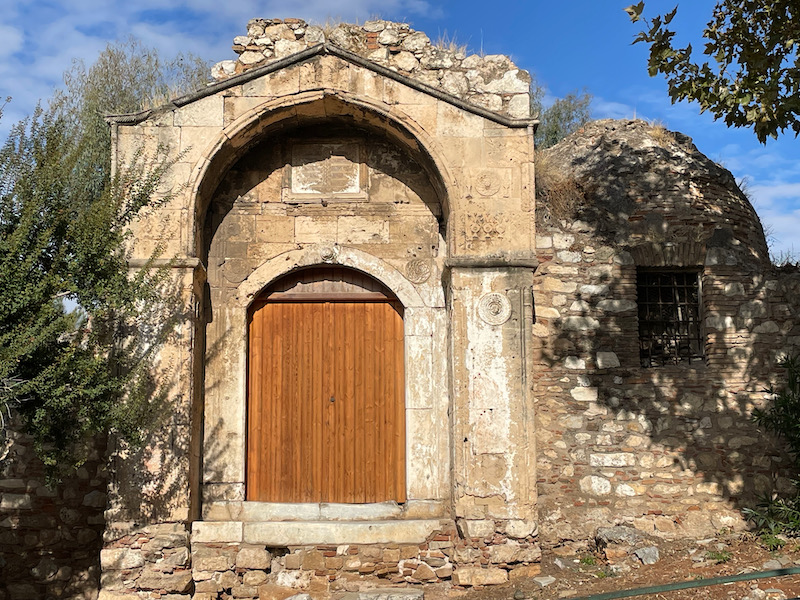
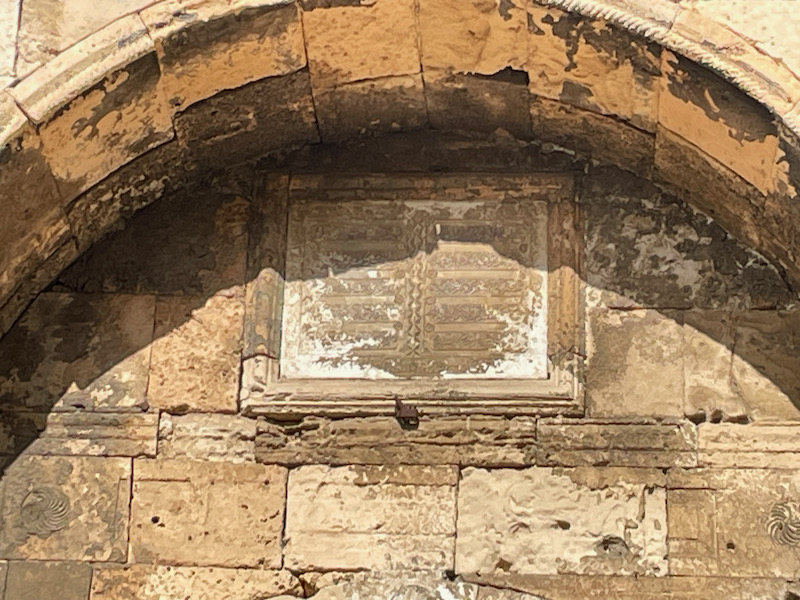
Hadrian's Library is quite a large complex from the 2nd century AD with a few pieces remaining visible. Emperor Hadrian, a fervent admirer of Greek culture, outfitted this expansive complex with art galleries, lecture halls, and a grand central public space. His rule marked an era of peace and prosperity, fostering the flourishing of arts and culture; that left an indelible mark on the Roman Empire. Originally, the library housed valuable papyrus scrolls and various artwork. Over time, it became the site of 3 churches: a Byzantine church dating back to the 5th century, a 7th-century church, and a 12th-century cathedral.
Where you enter today is probably the most impressive part, as you can see a large wall with a set of columns. I made Tom get in the picture (he is REALLY small) to give you an idea of the scale of this building!
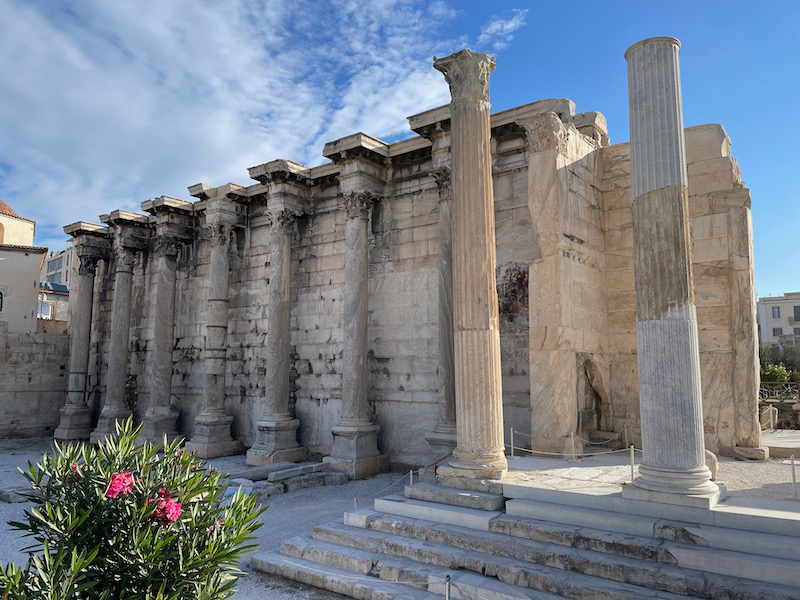
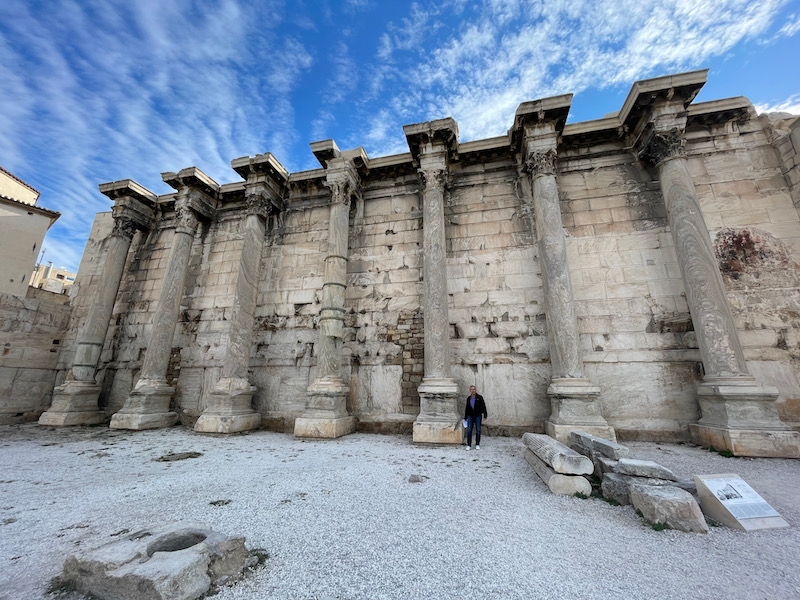
There are actually quite a few things within the complex, like 2 auditoriums, multiple reading rooms, and lecture halls. But in general, today they are nothing more than a few large stones that come together to form an outline on the ground. You can get a bit of an idea from the size of the stones making up the walls, and the columns that dot the area.
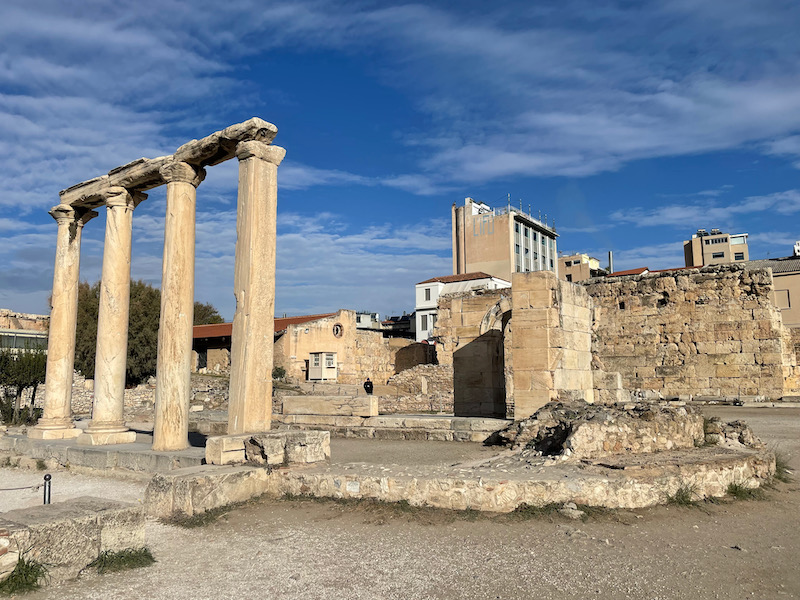
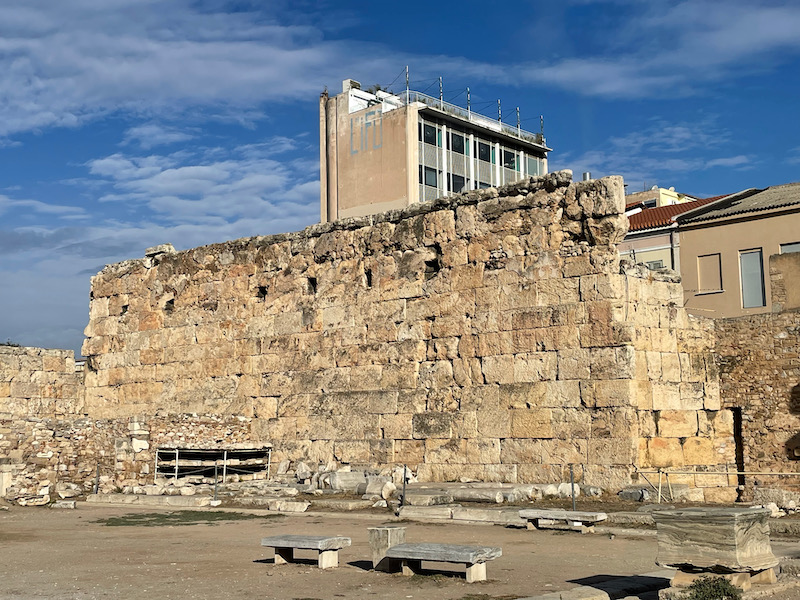
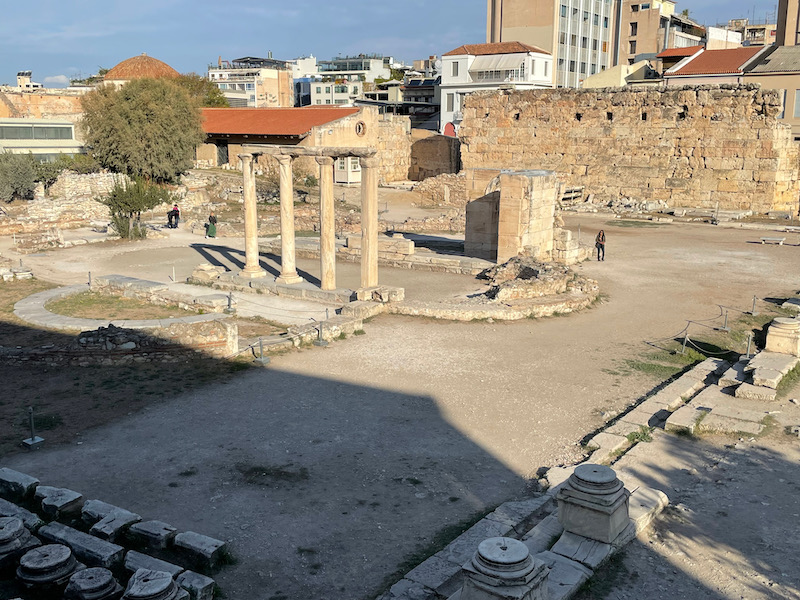
The first church here, built in the 5th century, was built within the courtyard of the library (which gives you an idea of just how large the library itself was). It isn't that easy to see but here you can see an outer semi-circle and then a smaller inner semi-circle. The church had 3 of these at one ind of the church. You can also an inner wall and archway, that gave access to the interior of that part of the church. I have a little diagram of the plan, and these 2 semi-circles are what you see on the bottom, and you can even see the little empty space where that archway is. Thank goodness for drawings!
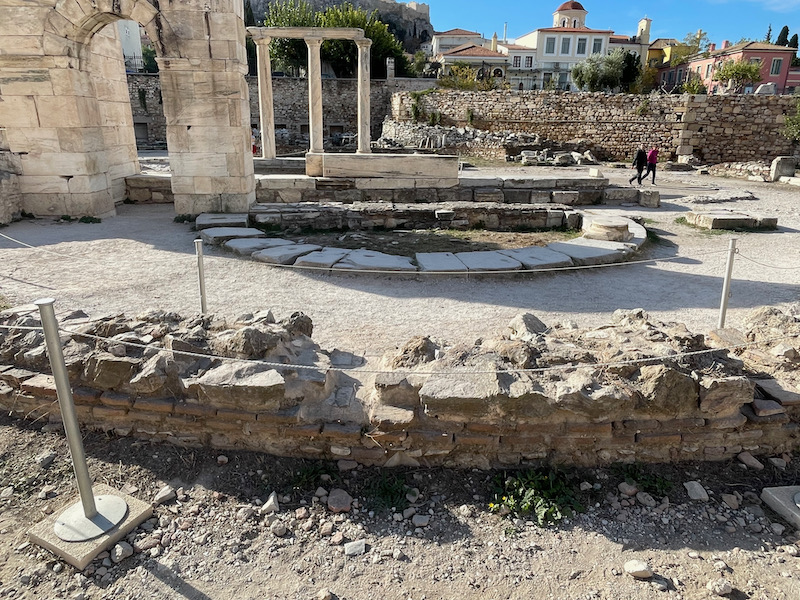
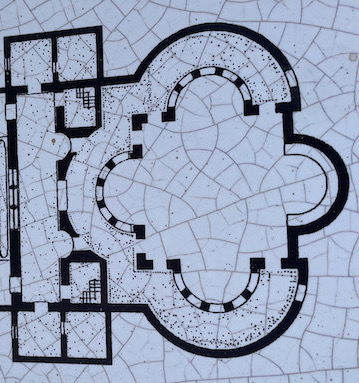
There were a few mosaics that were visible, and while there wasn't anything to tell me about them, I did find information that said these were from the 7th century Basilica.
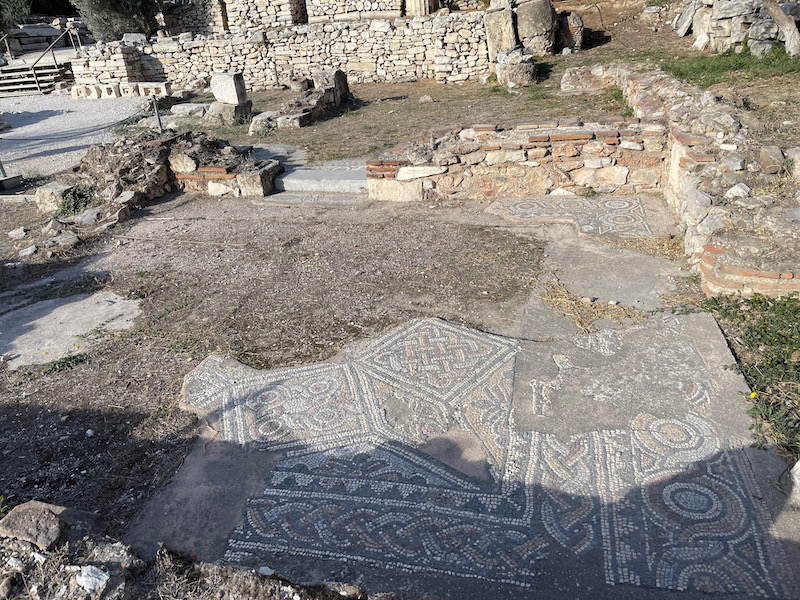
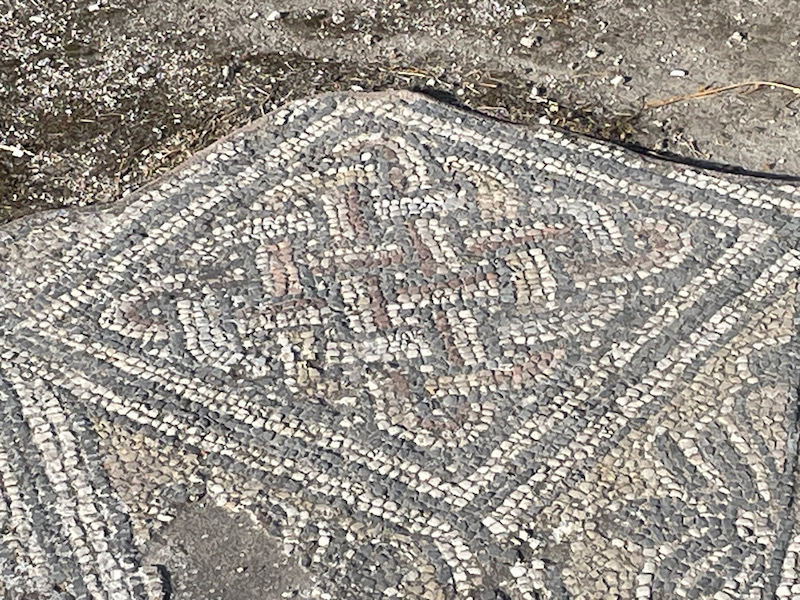
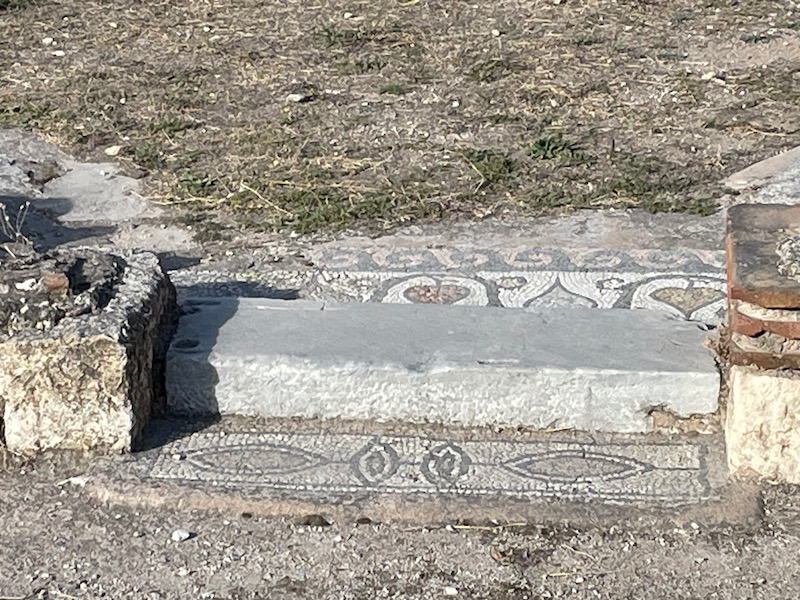
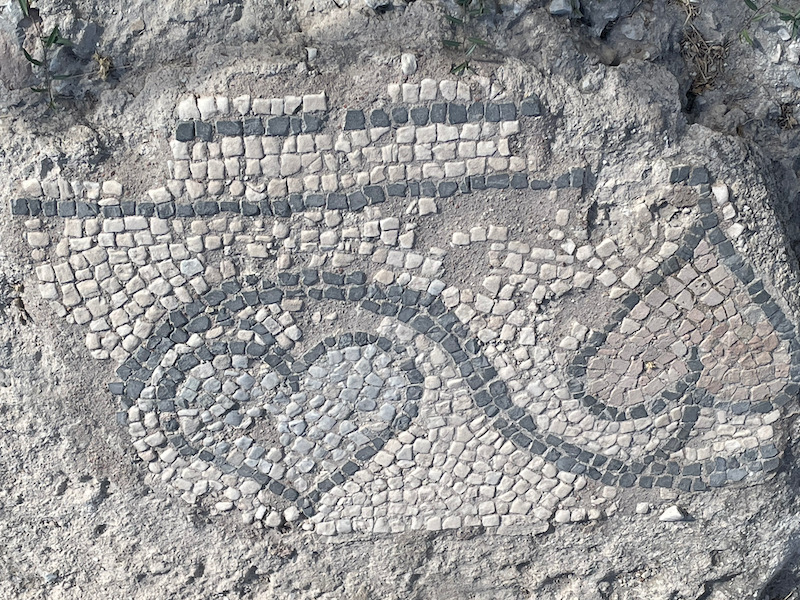
The 3rd church, a 12th century Cathedral, burned down and was demolished in 1885 so that the first archaeological excavations could take place.
From Hadrian's Library to Hadrian's Hadrian's Gate. Here you see it from the "road" side, built around 131 AD. It has 2 different styles ... the bottom takes the form of a Roman triumphal arch while the top has the shape of a Greek temple. There are inscriptions on both sides of the archway itself: one says "This is Athens, the ancient city of Theseus" while the other reads "This is the city of Hadrian and not of Theseus".
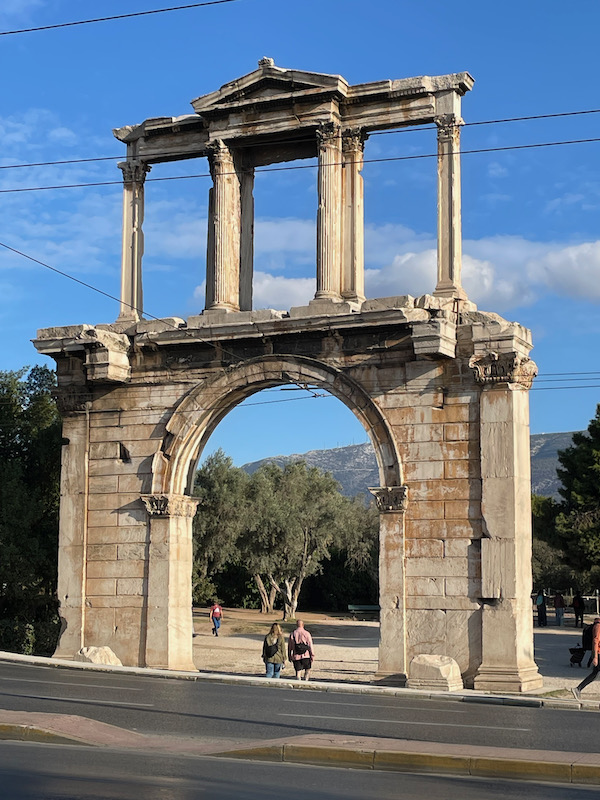
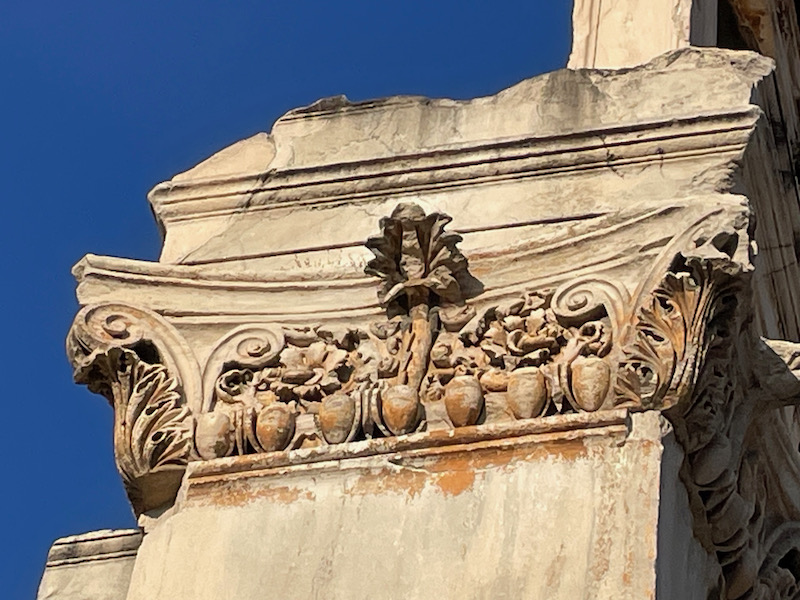
The gate leads to the Temple of Olympian Zeus. It was started in the 6th century BC during the rule of the Athenian tyrants but was not completed until the reign of Roman Emperor Hadrian in the 2nd century AD. During the Roman period, the temple, which included 104 colossal columns, was renowned as the largest temple in Greece and housed one of the largest cult statues in the ancient world. But it didn't stay for long ... it fell into disuse during a barbarian invasion in 267 AD and was reduced to ruins. In the centuries after the fall of the Roman Empire, it was used for building materials in the city. In 1436, a traveler wrote that 21 columns were standing but now there are 15 columns standing and a 16th lies on the ground where it fell during a storm in 1852. Unfortunately, most of them are hidden under scaffolding.
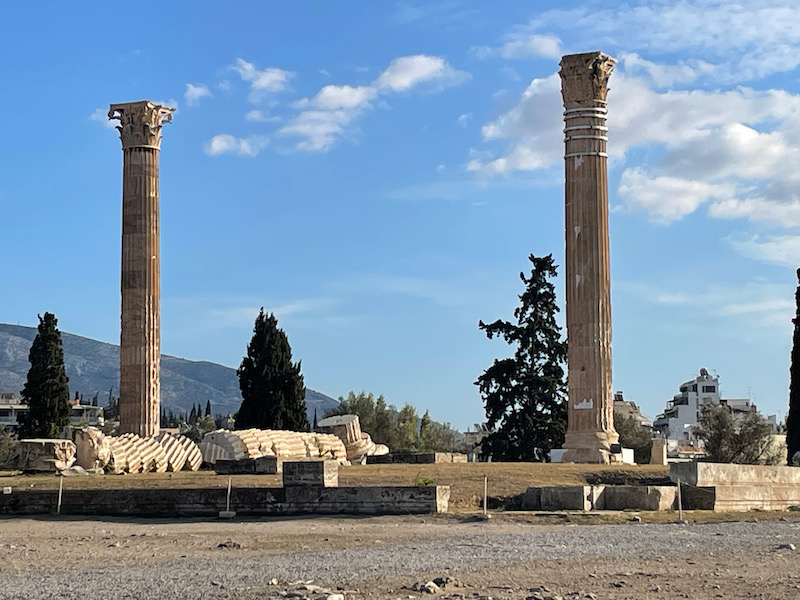
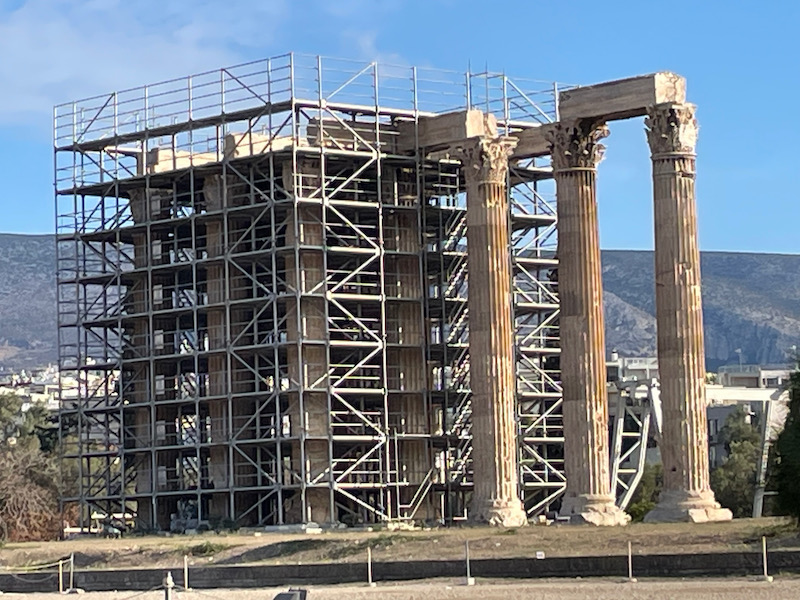
A view from the temple-side of the arch (which looks identical to the other side). And then a slightly different angle, where you can better see the Acropolis just underneath the archway.
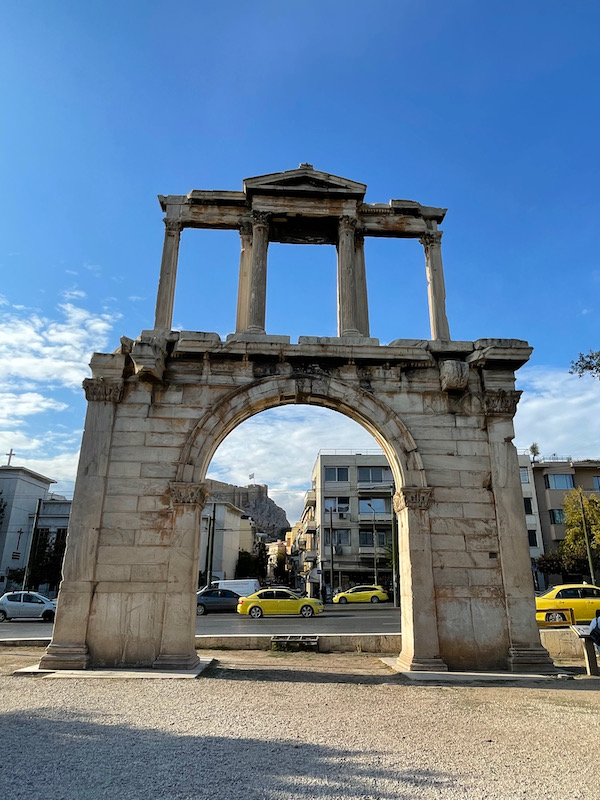
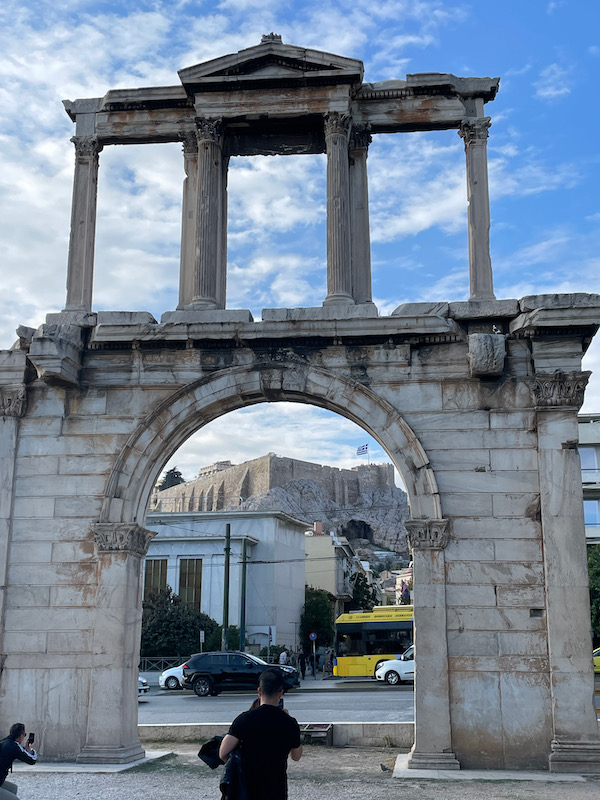
We didn't go to the Acropolis this trip, but I did get some pictures of it from various places and at different times of the day. So I will give a little information on it. The word "acropolis" is used very generically across Greece for any high point above a city. For example, Acrocorinth is the Acropolis of Corinth. The buildings that are built on top of the Acropolis of Athens were started in the 5th century BC. I don't know for sure what all of the temples that you can see here are, but maybe a part of the Parthenon, the Temple of Athena Nike, and the Erechtheion.
